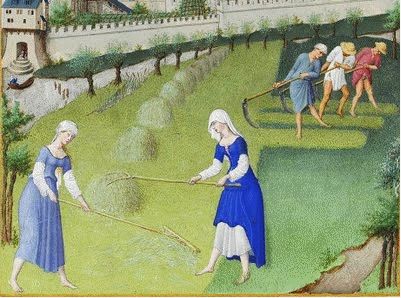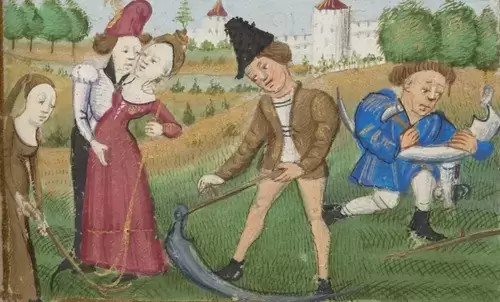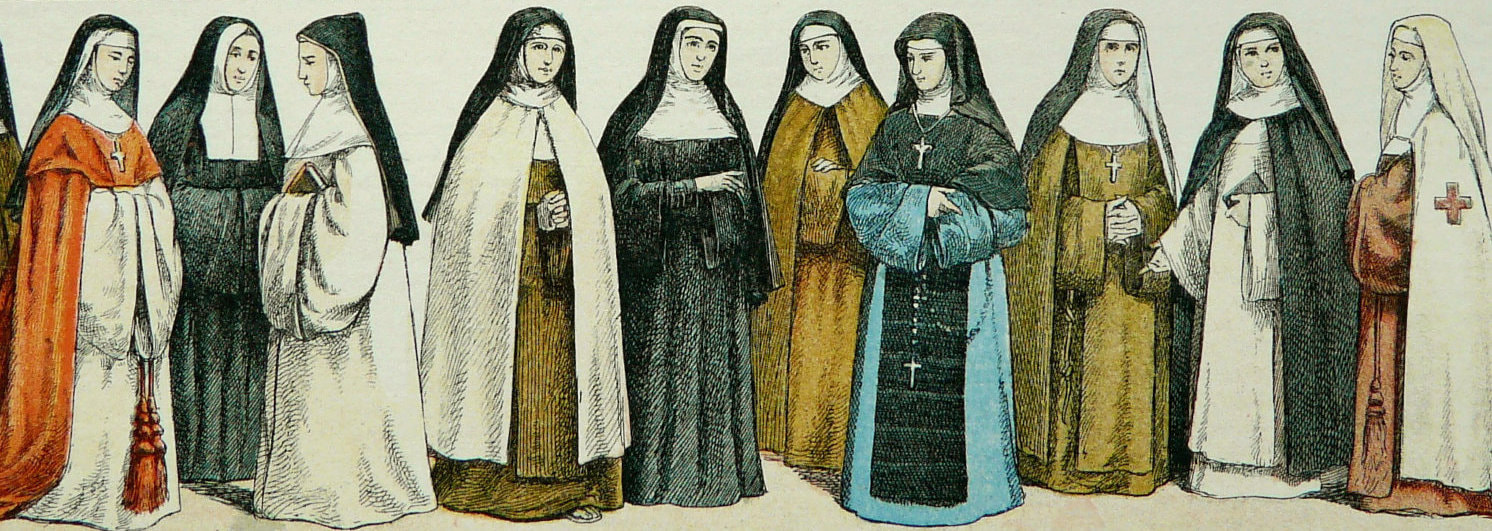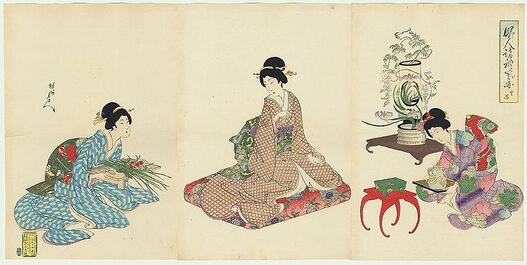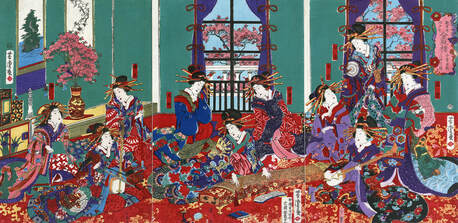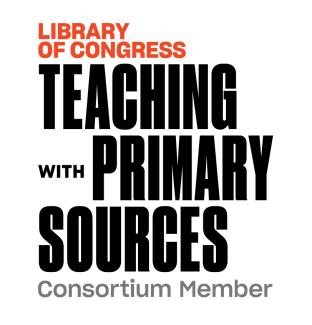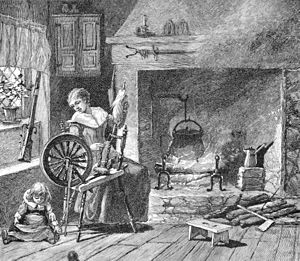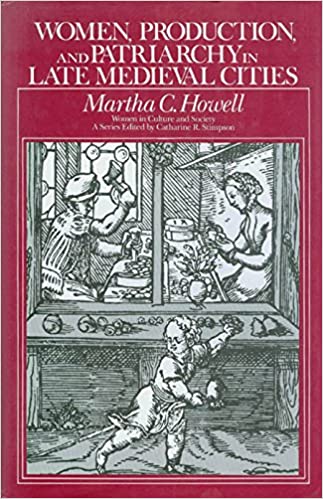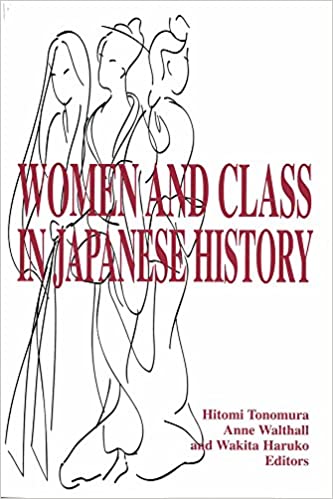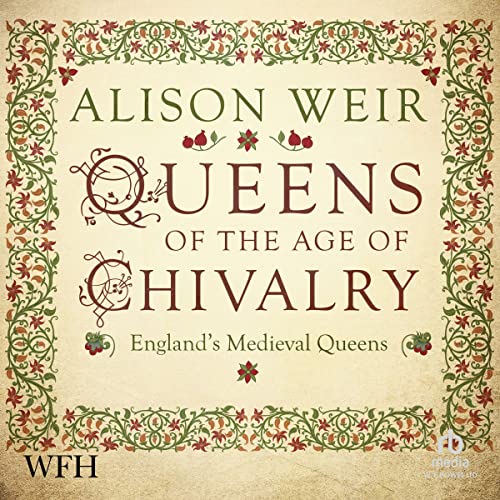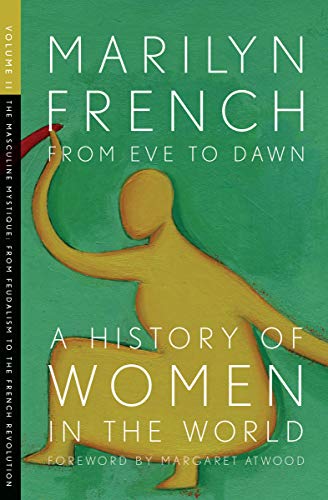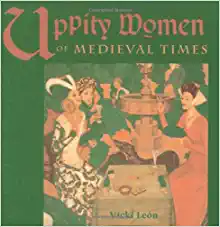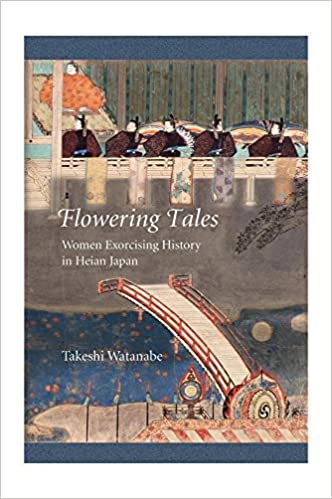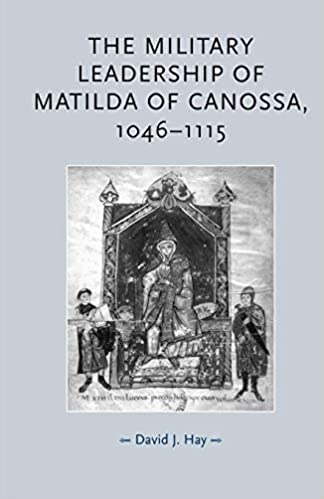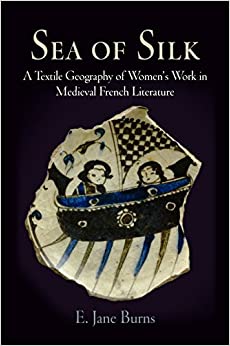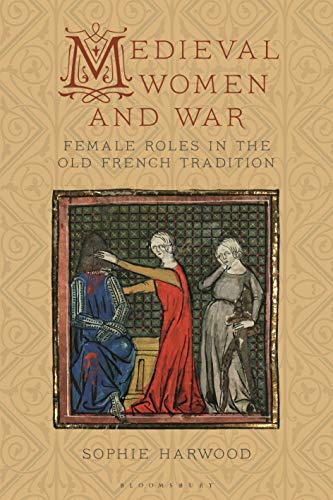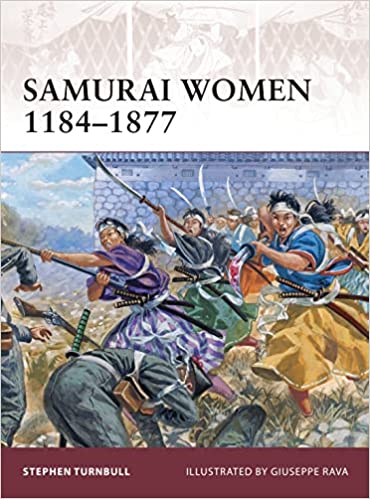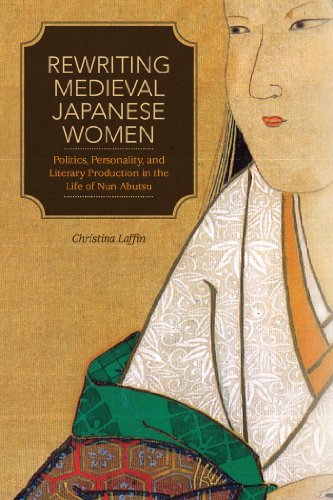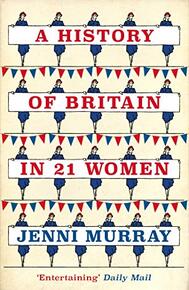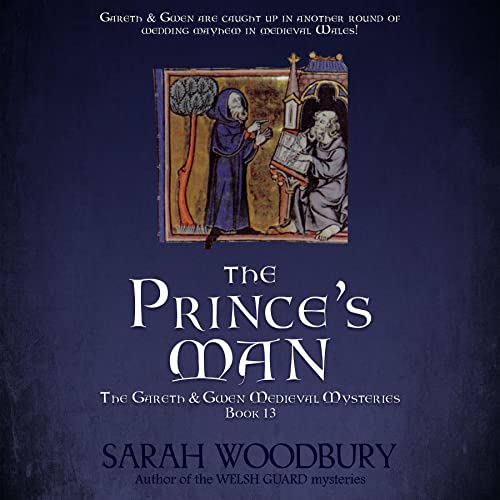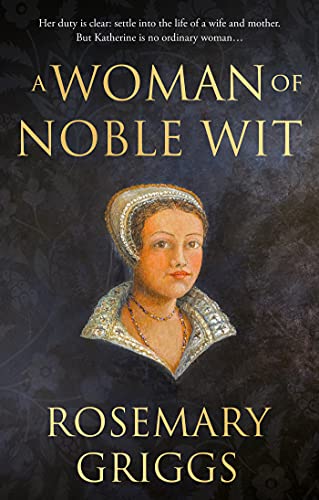13. 1000-1500 Women and Feudalism in Europe and Japan
|
In Europe and Japan, women labored in cottage industries and were an integral part of rigid caste systems. Lower class women had few rights, while upper class women had a small degree of freedom. In both cases, women found peace in nunneries and a few rose to positions of power.
|
Feudalism was the dominant social, political, and economic system in the Middle Ages in Europe and Japan. In this system, the nobility was gifted lands by the Monarch in exchange for military service as knights. Vassals rented and worked lands as tenants of the nobles. Peasants, also known as Serfs in some places, were given protection of sorts, but they basically lived as slaves on the land, paid homage to the nobles, labored hard, and had to give up portions of their crops. Women in Europe and Japan lived similar lives under feudalism.
In both regions, the lord of the land was responsible for and rigidly controlled all aspects of the lower class serf's life, including his wife and daughters. The lord chose brides for men, and the daughter of a serf was essentially property of the lord, as were her parents.
Married women were controlled under a system of coverture, where her interests and behavior were the responsibility of her husband. In legal battles, women are barely mentioned. A husband would be sued when a wife broke the law.
In both cultures, higher-class women were given more opportunities, but they were still held to strict sexual behaviors and expected to be mothers. There are exceptions to this "rule," but they were very rare. What was life like for poor and middle tier women?
Feudal Labor
In the Middle Ages, women in Europe entered a period of great change. The planet warmed a bit, allowing for longer growing seasons, and this phenomenon led to a push to clear and settle more lands. The stability of the period also led to population growth. European cities reached the tens to hundred thousands. Population growth had an impact on women’s roles in society, and forced them into greater domestic responsibilities.
The majority lived in small rural farming societies. Peasant women had many domestic responsibilities, including caring for children, preparing food, and tending livestock. During the harvest, women worked in the fields too. Women labored in their communities, tending their children, their farms, their homes, and their family businesses. Working women were the fabric that held communities together, yet farm records only recorded the output of the farmer, ignoring the labor of his wife. This calculation is lost to history and we can find only glimpses in court records regarding defiant women.
In both regions, the lord of the land was responsible for and rigidly controlled all aspects of the lower class serf's life, including his wife and daughters. The lord chose brides for men, and the daughter of a serf was essentially property of the lord, as were her parents.
Married women were controlled under a system of coverture, where her interests and behavior were the responsibility of her husband. In legal battles, women are barely mentioned. A husband would be sued when a wife broke the law.
In both cultures, higher-class women were given more opportunities, but they were still held to strict sexual behaviors and expected to be mothers. There are exceptions to this "rule," but they were very rare. What was life like for poor and middle tier women?
Feudal Labor
In the Middle Ages, women in Europe entered a period of great change. The planet warmed a bit, allowing for longer growing seasons, and this phenomenon led to a push to clear and settle more lands. The stability of the period also led to population growth. European cities reached the tens to hundred thousands. Population growth had an impact on women’s roles in society, and forced them into greater domestic responsibilities.
The majority lived in small rural farming societies. Peasant women had many domestic responsibilities, including caring for children, preparing food, and tending livestock. During the harvest, women worked in the fields too. Women labored in their communities, tending their children, their farms, their homes, and their family businesses. Working women were the fabric that held communities together, yet farm records only recorded the output of the farmer, ignoring the labor of his wife. This calculation is lost to history and we can find only glimpses in court records regarding defiant women.
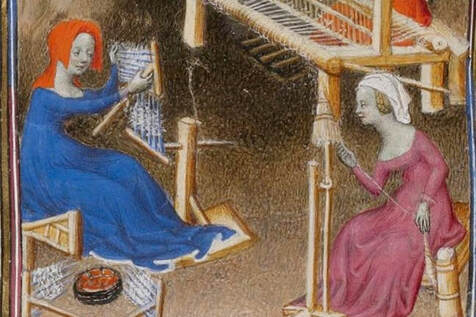 Cottage Industries, Public Domain
Cottage Industries, Public Domain
Women worked in vital cottage industries; brewing beer, baking, and weaving or manufacturing textiles. There were few jobs working women were excluded from when they needed to be done. Women and their families worked in unison for the success of the family. Women’s work was under compensated. Records show them earning around three-quarters what men earned.
Women were active in urban professions like milling grain, midwifery, laundering, spinning, and prostitution. Estimates vary depending on the location, but between one third and almost half of merchants in European urban areas were female.Widows in particular continued their husband's businesses and used their wealth to support wars.
Women's guilds were disappearing and even brothels were run mainly by male owners. In places like England regulations outlawed women’s participation in lucrative fields, thus keeping wealth in the hands of men. Weaving had long been an occupation of women, but larger looms and mills powered by animals or water made production more efficient and provided thicker cloth. Thus men took over these profitable businesses. Sons were trained as apprentices, blocking women from entering the profession.
Women’s labor was often multifaceted, menial, and constant. Men’s work by contrast was dangerous and exhausting. While men were singularly focused, women balanced many tasks.
An English poem made this point plain, “For man’s work ends at setting sun, Yet woman’s work is never done.” Wherever they labored, and no matter how hard women worked, they were paid less than men. Cecelia Penifader was an unmarried woman of the lower class whose family's prosperity allowed her to lead an independent life. She earned one-third less than men doing unskilled labor.
Women were active in urban professions like milling grain, midwifery, laundering, spinning, and prostitution. Estimates vary depending on the location, but between one third and almost half of merchants in European urban areas were female.Widows in particular continued their husband's businesses and used their wealth to support wars.
Women's guilds were disappearing and even brothels were run mainly by male owners. In places like England regulations outlawed women’s participation in lucrative fields, thus keeping wealth in the hands of men. Weaving had long been an occupation of women, but larger looms and mills powered by animals or water made production more efficient and provided thicker cloth. Thus men took over these profitable businesses. Sons were trained as apprentices, blocking women from entering the profession.
Women’s labor was often multifaceted, menial, and constant. Men’s work by contrast was dangerous and exhausting. While men were singularly focused, women balanced many tasks.
An English poem made this point plain, “For man’s work ends at setting sun, Yet woman’s work is never done.” Wherever they labored, and no matter how hard women worked, they were paid less than men. Cecelia Penifader was an unmarried woman of the lower class whose family's prosperity allowed her to lead an independent life. She earned one-third less than men doing unskilled labor.
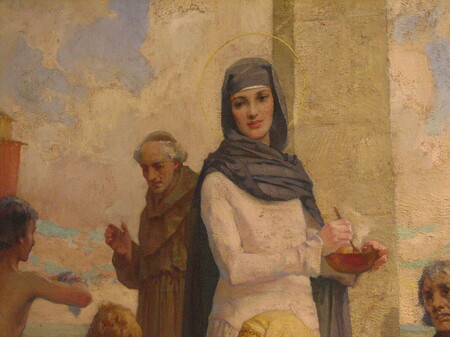 Abbess Hilda, Wikimedia Commons
Abbess Hilda, Wikimedia Commons
Feudal England
In pre-feudal England, Anglo-Saxon society had well defined codes of laws, diverse trade, talented artisans, and connections to learning on the continent. The Anglo-Saxons were converted to Christianity in 597, by Augustine whose mission was commissioned by Pope Gregory and sponsored by Queen Brunhild in Francia.
The Celtic Christian Church maintained a number of practices that diverged from those of the Roman Catholic Church. In 644, the Abbess Hilda hosted a meeting at Whitby to reconcile the churches. The result was a unified church with Roman authority superseding the Celtic church. Hilda’s accomplishment left her venerated on statues, crosses, and in Stained Glass windows within churches. A homily to Hilda captured her spirit: “Bend your minds to holy learning that you may escape the fretting moth of littleness of mind that would wear out your souls. Train your hearts and lips to song which gives courage to the soul.”
By 900 the English were unquestioningly Christian, but pagan traditions were integrated in the daily lives of the working class. Eostre, for example, the Anglo-Saxon goddess of spring, merged into the Christian celebration of Easter, which is why flowers and eggs became part of celebrating the resurrection.
Women in England had more independence than their feudal counterparts. Germanic tribes had long held power in the hands of priestesses and queens. And in many ways they were seen as equal. This is exemplified by women’s wergild, or “blood price” paid if they were murdered, which was equal to men’s. Married women were expected to be active partners. Husbands brought property and gifts for their brides, rather than the brides bringing dowries.Women had the right to divorce, and could take with them half of the family wealth. They also had relative control over their finances, including the right to hold land in their own name and to defend themselves in court.
In pre-feudal England, Anglo-Saxon society had well defined codes of laws, diverse trade, talented artisans, and connections to learning on the continent. The Anglo-Saxons were converted to Christianity in 597, by Augustine whose mission was commissioned by Pope Gregory and sponsored by Queen Brunhild in Francia.
The Celtic Christian Church maintained a number of practices that diverged from those of the Roman Catholic Church. In 644, the Abbess Hilda hosted a meeting at Whitby to reconcile the churches. The result was a unified church with Roman authority superseding the Celtic church. Hilda’s accomplishment left her venerated on statues, crosses, and in Stained Glass windows within churches. A homily to Hilda captured her spirit: “Bend your minds to holy learning that you may escape the fretting moth of littleness of mind that would wear out your souls. Train your hearts and lips to song which gives courage to the soul.”
By 900 the English were unquestioningly Christian, but pagan traditions were integrated in the daily lives of the working class. Eostre, for example, the Anglo-Saxon goddess of spring, merged into the Christian celebration of Easter, which is why flowers and eggs became part of celebrating the resurrection.
Women in England had more independence than their feudal counterparts. Germanic tribes had long held power in the hands of priestesses and queens. And in many ways they were seen as equal. This is exemplified by women’s wergild, or “blood price” paid if they were murdered, which was equal to men’s. Married women were expected to be active partners. Husbands brought property and gifts for their brides, rather than the brides bringing dowries.Women had the right to divorce, and could take with them half of the family wealth. They also had relative control over their finances, including the right to hold land in their own name and to defend themselves in court.
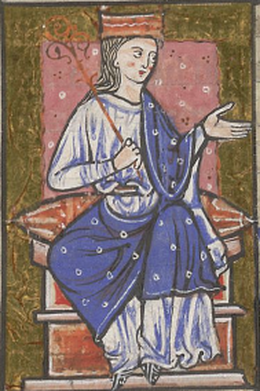 Aethelflaed, Wikimedia Commons
Aethelflaed, Wikimedia Commons
But of course there were class differences here. Upper class women had more freedom. They received an education and managed their estates and finances. Nevertheless, women were barred from learning Latin, perhaps as a way of keeping them away from Church policy and administration.
Aethelflaed, Lady of the Mercians
The best example of a powerful elite woman is Aethelflaed, the daughter of Alfred the Great and one of the greatest military commanders in medieval England. She received an elaborate education for a girl of her time which included political and military training. She was eventually married to Aethelred of Mercia in a political alliance to unite the two kingdoms. The two held equal power. When he died, she took sole control of the kingdom of Mercia titling herself, “Lady of the Mercians” instead of queen.
When her younger brother, Edward, ascended to the throne, this brother-sister duo proved to be a formidable team. They fought against Danish Vikings who ruled nearby kingdoms, which is where her military strategy shone and earned her the respect of her peers. In 917, her brother distracted the Danes elsewhere while she took control of the heart of Danish fortifications by surprise. She also invested in fortresses, providing effective defenses against the Danes. Together Aethelflaed and her brother helped secure England from the Vikings.
In 918, at the peak of her power, Aethelflaed became sick and died. In many ways, her death was more significant to the lives of English people than that of her father or her brother. In a history written two centuries later, William of Malmesbury, described Aethelflaed as a “powerful member of king Edward’s party, the delight of her subjects, and the dread of his enemies. She was a spirited heroine who assisted her brother greatly with her advice. She was of equal service in building cities, and, whether through fortune or her own efforts, was a woman who protected men at home and intimidated them abroad.”
Aethelflaed, Lady of the Mercians
The best example of a powerful elite woman is Aethelflaed, the daughter of Alfred the Great and one of the greatest military commanders in medieval England. She received an elaborate education for a girl of her time which included political and military training. She was eventually married to Aethelred of Mercia in a political alliance to unite the two kingdoms. The two held equal power. When he died, she took sole control of the kingdom of Mercia titling herself, “Lady of the Mercians” instead of queen.
When her younger brother, Edward, ascended to the throne, this brother-sister duo proved to be a formidable team. They fought against Danish Vikings who ruled nearby kingdoms, which is where her military strategy shone and earned her the respect of her peers. In 917, her brother distracted the Danes elsewhere while she took control of the heart of Danish fortifications by surprise. She also invested in fortresses, providing effective defenses against the Danes. Together Aethelflaed and her brother helped secure England from the Vikings.
In 918, at the peak of her power, Aethelflaed became sick and died. In many ways, her death was more significant to the lives of English people than that of her father or her brother. In a history written two centuries later, William of Malmesbury, described Aethelflaed as a “powerful member of king Edward’s party, the delight of her subjects, and the dread of his enemies. She was a spirited heroine who assisted her brother greatly with her advice. She was of equal service in building cities, and, whether through fortune or her own efforts, was a woman who protected men at home and intimidated them abroad.”
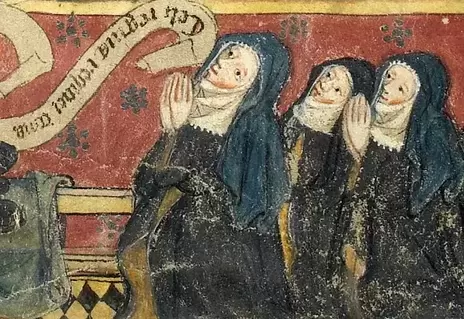 Medieval Nuns, Public Domain
Medieval Nuns, Public Domain
Nunneries
In the early Middle Ages, nunneries provided opportunity and sanctuary for women of all classes generally outside the control of men. Women in these nunneries wielded enormous power and had lasting influence on scholarship of the time. Abbesses ruled over land, commanded armies, used their own coins, and even had their own courts. Abbesses heard confession, gave absolution and benediction, and some even went by the title “majesty.”
A woman from the aristocracy had two life paths: marry into financial security or become a nun. Being some of the few women with education and the resources for a dowry to the Church, nuns were recruited almost exclusively from the aristocracy. But certainly women of lower classes found themselves in convents as well. Women joined nunneries for piety, but there were also more practical reasons such as self-preservation. Medieval women in nunneries lived longer than their married sisters because of the high-risk in childbirth. Some women retired to nunneries in widowhood. Incoming nuns paid dowries of land or coin to the church. The standard of living was pretty high. Nuns worked in the Scriptorium, did domestic labor, and worked in Shops.
Convents provided intellectual opportunity for women denied to them elsewhere. Historian Rosalind Miles suggested marriage was the “enemy of any woman’s intellectual development” and Historian Joshua J. Mark stated, “The nunnery was a refuge of female intellectuals.” Nonconforming women, queer women, women who didn’t want to get married, and women who found the prospects of housekeeping and childrearing abhorrent, sought the covenant with enthusiasm. There is abundant correspondence from this time that highlights the daily lives of the nuns and shows that they did serious scholarship equal to that created by monks. The nun Lioba claimed she only put her books down to sleep. Hroswitha of Gandersheim wrote seven Latin plays in the 900s making her the world's first humanist for her abundant love of classical literature.
But by the 900s and 1000s, there was a major decline in the opportunities available to nuns. The church was overwhelmingly masculine in its power structure and became increasingly concerned about women and the time-honored-tradition of silencing them. Therefore, their public activity, status in church, and educational opportunities all declined in the mid and late Middle Ages. Double houses disappeared and nuns were forced to live in strict enclosures or in seclusion, completely separated from the male monks. Nuns were forced to rely on male priests for all sacraments, including confessions. The contributions of nuns to scholarship and learning declined. Phillippe of Navarre, writing in 1300, reflected the general sentiment about learned women: “One should not teach a woman letters or writing unless she is a nun, because a woman’s reading and writing leads to great evil.” Even in all-female covenants, all the opportunities for status and advancement available to male scholars were denied to them.
The increasing hostility toward the essence of womanhood saw a parallel rise in the adoration of the Virgin Mary. There was a thriving religious mysticism around her that the church saw as basically heresy. Although honoring the mother of Christ could be seen as a net win for Womankind. In reality, it only led to their subordination. Proponents felt that the essence of a woman was her innocence. To educate her would be to pollute her. The rationale to deprive women of an education deepened.
In the early Middle Ages, nunneries provided opportunity and sanctuary for women of all classes generally outside the control of men. Women in these nunneries wielded enormous power and had lasting influence on scholarship of the time. Abbesses ruled over land, commanded armies, used their own coins, and even had their own courts. Abbesses heard confession, gave absolution and benediction, and some even went by the title “majesty.”
A woman from the aristocracy had two life paths: marry into financial security or become a nun. Being some of the few women with education and the resources for a dowry to the Church, nuns were recruited almost exclusively from the aristocracy. But certainly women of lower classes found themselves in convents as well. Women joined nunneries for piety, but there were also more practical reasons such as self-preservation. Medieval women in nunneries lived longer than their married sisters because of the high-risk in childbirth. Some women retired to nunneries in widowhood. Incoming nuns paid dowries of land or coin to the church. The standard of living was pretty high. Nuns worked in the Scriptorium, did domestic labor, and worked in Shops.
Convents provided intellectual opportunity for women denied to them elsewhere. Historian Rosalind Miles suggested marriage was the “enemy of any woman’s intellectual development” and Historian Joshua J. Mark stated, “The nunnery was a refuge of female intellectuals.” Nonconforming women, queer women, women who didn’t want to get married, and women who found the prospects of housekeeping and childrearing abhorrent, sought the covenant with enthusiasm. There is abundant correspondence from this time that highlights the daily lives of the nuns and shows that they did serious scholarship equal to that created by monks. The nun Lioba claimed she only put her books down to sleep. Hroswitha of Gandersheim wrote seven Latin plays in the 900s making her the world's first humanist for her abundant love of classical literature.
But by the 900s and 1000s, there was a major decline in the opportunities available to nuns. The church was overwhelmingly masculine in its power structure and became increasingly concerned about women and the time-honored-tradition of silencing them. Therefore, their public activity, status in church, and educational opportunities all declined in the mid and late Middle Ages. Double houses disappeared and nuns were forced to live in strict enclosures or in seclusion, completely separated from the male monks. Nuns were forced to rely on male priests for all sacraments, including confessions. The contributions of nuns to scholarship and learning declined. Phillippe of Navarre, writing in 1300, reflected the general sentiment about learned women: “One should not teach a woman letters or writing unless she is a nun, because a woman’s reading and writing leads to great evil.” Even in all-female covenants, all the opportunities for status and advancement available to male scholars were denied to them.
The increasing hostility toward the essence of womanhood saw a parallel rise in the adoration of the Virgin Mary. There was a thriving religious mysticism around her that the church saw as basically heresy. Although honoring the mother of Christ could be seen as a net win for Womankind. In reality, it only led to their subordination. Proponents felt that the essence of a woman was her innocence. To educate her would be to pollute her. The rationale to deprive women of an education deepened.
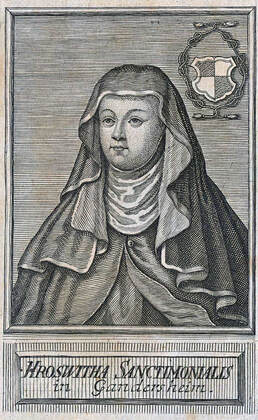 Hroswitha of Gandersheim, Public Domain
Hroswitha of Gandersheim, Public Domain
Hroswitha Gandersheim
Hroswitha of Gandersheim was a canoness, working in the scriptorium to record documents in the 900s in Saxony. She was a noblewoman given to the nunnery as a child to acquire an education. The Gandersheim nunnery was the center of intellectual activity in Germany. Hroswitha became an Abbess and negotiated with the German Holy Roman Emperor to hold her own court and coin money. She was called the “strong voice of Gandersheim.”
She was the first female German historian to write a long poem about Otto I’s rule, documenting the struggle between paganism and Christianity. She wrote legends about the Saints and was the first known playwright of Christianity, having written six plays! She took a stand for women. The characters and plots in her plays countered the religious dogma that suggested women were corruptible and weak.
She said, “Sometimes I compose with great effort, again I destroyed what I had poorly written...[so that] the slight talent...given me by Heaven should not lie idle in the dark recesses of the mind and thus be destroyed by the rush of neglect.”
Hroswitha of Gandersheim was a canoness, working in the scriptorium to record documents in the 900s in Saxony. She was a noblewoman given to the nunnery as a child to acquire an education. The Gandersheim nunnery was the center of intellectual activity in Germany. Hroswitha became an Abbess and negotiated with the German Holy Roman Emperor to hold her own court and coin money. She was called the “strong voice of Gandersheim.”
She was the first female German historian to write a long poem about Otto I’s rule, documenting the struggle between paganism and Christianity. She wrote legends about the Saints and was the first known playwright of Christianity, having written six plays! She took a stand for women. The characters and plots in her plays countered the religious dogma that suggested women were corruptible and weak.
She said, “Sometimes I compose with great effort, again I destroyed what I had poorly written...[so that] the slight talent...given me by Heaven should not lie idle in the dark recesses of the mind and thus be destroyed by the rush of neglect.”
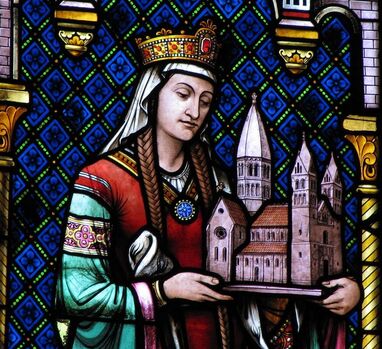 Hildegard of Bingen, Public Domain
Hildegard of Bingen, Public Domain
Hildegard of Bingen
Some medieval women were able to bypass misogyny and forge meaningful careers through the church. One of the more notable of these women was Hildegard de Bingen in Germany. She was a nun turned abbess, turned scholar, and Christian mystic. She was brilliant, and her research and written works touched many fields, from philosophy to musical composition, herbology to medieval literature, cosmology to medicine. In one of her books she identified almost 300 herbs. In another, she listed and suggested causes and remedies for 47 different illnesses. She was also interested in understanding the female reproductive system.
She had visions that she believed, as was common at the time, foretold the future. She, a woman, wrote interpretations of those visions. Popes, emperors, and kings accepted her writings.She regularly defied the patriarchal hierarchy of her profession and pushed boundaries for women. She was unanimously selected as abbess after growing the reputation and wealth of the convent for many years. She requested permission to build her own content away from patriarchal influences. She was denied but persisted and eventually founded the convent at Rupertsberg c. 1150 CE. There, Hildegard was free to explore her spiritual and intellectual ideas.
She corresponded with extraordinary women of her time, including Eleanor of Aquitaine. She lamented bad leadership and corrupt governments stating, “You neglect Justice….you permit her to lie prostrate on the earth.”
She fell in love with another nun whose wealthy family later separated them. Their letters reveal their painful heartbreak. Her love died from illness a short time later, leaving her stunned.
Her theology emphasized the feminine, and she thought women had just as important roles to play as men. She was widely popular and went on four speaking tours in defiance of prescriptions that women should stay silent in churches and in public.
Reflecting on her life, she claimed she was a “poor uneducated woman.” But she justified her work as her contribution to posterity. She wrote that she was asked to write, “for the benefit of mankind.”
Some medieval women were able to bypass misogyny and forge meaningful careers through the church. One of the more notable of these women was Hildegard de Bingen in Germany. She was a nun turned abbess, turned scholar, and Christian mystic. She was brilliant, and her research and written works touched many fields, from philosophy to musical composition, herbology to medieval literature, cosmology to medicine. In one of her books she identified almost 300 herbs. In another, she listed and suggested causes and remedies for 47 different illnesses. She was also interested in understanding the female reproductive system.
She had visions that she believed, as was common at the time, foretold the future. She, a woman, wrote interpretations of those visions. Popes, emperors, and kings accepted her writings.She regularly defied the patriarchal hierarchy of her profession and pushed boundaries for women. She was unanimously selected as abbess after growing the reputation and wealth of the convent for many years. She requested permission to build her own content away from patriarchal influences. She was denied but persisted and eventually founded the convent at Rupertsberg c. 1150 CE. There, Hildegard was free to explore her spiritual and intellectual ideas.
She corresponded with extraordinary women of her time, including Eleanor of Aquitaine. She lamented bad leadership and corrupt governments stating, “You neglect Justice….you permit her to lie prostrate on the earth.”
She fell in love with another nun whose wealthy family later separated them. Their letters reveal their painful heartbreak. Her love died from illness a short time later, leaving her stunned.
Her theology emphasized the feminine, and she thought women had just as important roles to play as men. She was widely popular and went on four speaking tours in defiance of prescriptions that women should stay silent in churches and in public.
Reflecting on her life, she claimed she was a “poor uneducated woman.” But she justified her work as her contribution to posterity. She wrote that she was asked to write, “for the benefit of mankind.”
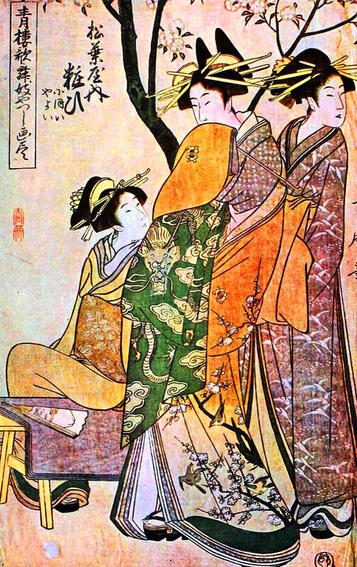 Japanese Women, Public Domain
Japanese Women, Public Domain
Feudal Japan
Across the world, a strikingly similar society existed on the islands of Japan. Japan adopted feudalism in 1192 with the rise of the first Shogun, Yoritomo. A shogun was an emperor by title but was more like a military ruler in practice. The shogun’s goal was to use his military prowess to prevent the return of civil war among the 260 daimyo, or feudal lords, each of whom had his own band of samurai soldiers.
Prior to the Shogunate, women in Japan had numerous privileges. They were allowed to own and inherit, unmarried women lived alone, and wife- beating was forbidden by law. Aristocrats were polygamous, but women lived with and were protected by their families. Their husbands would visit them. While this allowed women some independence, it also meant their spouse could easily desert them.
Before and after the rise of the shogunate, the idea of chivalry, which was important in Europe, did not exist. While women could influence affairs at court, they did so in a cloistered setting behind sliding screens. Unlike in Europe, women were given more sexual freedoms and would accept male visitors at night. Divorces were somewhat common and easy to obtain.
Aristocratic ladies lived lives of luxury, engaged in artistic pursuits, and had scandalous love affairs. Women writers were abundant in Japanese courts, and they developed a uniquely female style of writing as they were barred from learning Chinese, the official legal language in Japan. This was similar to the European custom that prohibited women from learning Latin. They wrote in everyday Japanese language in their diaries, novels, and poetry, making it widely readable and popular.
Across the world, a strikingly similar society existed on the islands of Japan. Japan adopted feudalism in 1192 with the rise of the first Shogun, Yoritomo. A shogun was an emperor by title but was more like a military ruler in practice. The shogun’s goal was to use his military prowess to prevent the return of civil war among the 260 daimyo, or feudal lords, each of whom had his own band of samurai soldiers.
Prior to the Shogunate, women in Japan had numerous privileges. They were allowed to own and inherit, unmarried women lived alone, and wife- beating was forbidden by law. Aristocrats were polygamous, but women lived with and were protected by their families. Their husbands would visit them. While this allowed women some independence, it also meant their spouse could easily desert them.
Before and after the rise of the shogunate, the idea of chivalry, which was important in Europe, did not exist. While women could influence affairs at court, they did so in a cloistered setting behind sliding screens. Unlike in Europe, women were given more sexual freedoms and would accept male visitors at night. Divorces were somewhat common and easy to obtain.
Aristocratic ladies lived lives of luxury, engaged in artistic pursuits, and had scandalous love affairs. Women writers were abundant in Japanese courts, and they developed a uniquely female style of writing as they were barred from learning Chinese, the official legal language in Japan. This was similar to the European custom that prohibited women from learning Latin. They wrote in everyday Japanese language in their diaries, novels, and poetry, making it widely readable and popular.
 Lady Murasaki, Wikimedia Commons
Lady Murasaki, Wikimedia Commons
Japanese Writers
Showing how smart you were was important in Japanese courts, and people were regularly challenged to prove their intellect. Aristocrats would have poetry contests that men and women would enter. To misquote or be proven wrong was equivalent to being socially humiliated.
Women writers were not only present, but prominent in Japan. Lady Murasaki wrote the world's first novel, The Tale of the Genji. The story is as long as an epic and follows the journey of a fictional prince. In the story, she wrote: “Without the novel what should we know of how people lived in the past from the age of the Gods down to the present day? For history books...show us only one corner of life; whereas the diaries and romances contain...the most minute information about people’s private affairs.”
Sei Shonagon wrote a collection of her vivid observations at court known as Pillow Book. She divided what she saw into categories like, “Annoying Things” and “Things Which Distract in Moments of Boredom.” In a detached way, she ranked and classified the people, events, and objects around her.
Showing how smart you were was important in Japanese courts, and people were regularly challenged to prove their intellect. Aristocrats would have poetry contests that men and women would enter. To misquote or be proven wrong was equivalent to being socially humiliated.
Women writers were not only present, but prominent in Japan. Lady Murasaki wrote the world's first novel, The Tale of the Genji. The story is as long as an epic and follows the journey of a fictional prince. In the story, she wrote: “Without the novel what should we know of how people lived in the past from the age of the Gods down to the present day? For history books...show us only one corner of life; whereas the diaries and romances contain...the most minute information about people’s private affairs.”
Sei Shonagon wrote a collection of her vivid observations at court known as Pillow Book. She divided what she saw into categories like, “Annoying Things” and “Things Which Distract in Moments of Boredom.” In a detached way, she ranked and classified the people, events, and objects around her.
Izumi was Japan’s most illustrious female poet. Her writings were erotic and anguished, and they reinforced the impermanence of life. She was born around 975 and grew up in the imperial court, where her father was a mid-level government official. There, girls of her status earned an education in poetry and the arts. She was married to a provincial governor but began an affair with the son of the emperor. When the emperor died the scandal reached its climax and she was divorced from her husband and estranged from her family. She then started a relationship with the emperor's brother and was invited to the prince's compound, much to the distress of his principal wife. Her life was marred by scandal. Lady Murasaki, a contemporary, wrote “how interestingly she writes. What a disgraceful person she is.” The irony is that all of the men had many concubines, but relations with a handful of men in her lifetime made her disgraced. She wrote her most famous poem while she was just a teenager: “from utter darkness/I must embark upon an/even darker Road/oh distant moon, cast your light/from the rim of the mountains.”
Convents in Japan
The Japanese worshiped the Goddess Amaterasu, known as “the great divinity illuminating heaven.” She was the sun goddess of Shintoism in Japan, which morphed with Buddhism as it spread throughout Asia. Amaterasu was the daughter of Izanami and Izanagi from the Japanese creation story, who made her ruler of the sky.
Women were religious leaders known as shamans in Shintoism. They were called upon in crisis to provide wisdom. Women participated equally in religious celebrations, some of which were designed specifically for women, such as the Maid Star.
Like wealthy European women, upper-class women in Japan found Buddhist convents appealing. Nunneries offered women leadership opportunities, intellectual pursuits, and an alternative to marriage. But Buddhism also lessened women’s status with its teachings that emphasized female deceitfulness and dishonesty.
Convents in Japan
The Japanese worshiped the Goddess Amaterasu, known as “the great divinity illuminating heaven.” She was the sun goddess of Shintoism in Japan, which morphed with Buddhism as it spread throughout Asia. Amaterasu was the daughter of Izanami and Izanagi from the Japanese creation story, who made her ruler of the sky.
Women were religious leaders known as shamans in Shintoism. They were called upon in crisis to provide wisdom. Women participated equally in religious celebrations, some of which were designed specifically for women, such as the Maid Star.
Like wealthy European women, upper-class women in Japan found Buddhist convents appealing. Nunneries offered women leadership opportunities, intellectual pursuits, and an alternative to marriage. But Buddhism also lessened women’s status with its teachings that emphasized female deceitfulness and dishonesty.
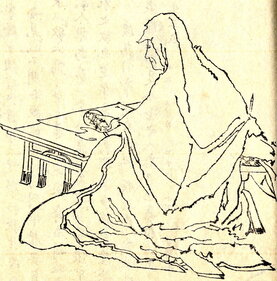 Masa-ko, Wikimedia Commons
Masa-ko, Wikimedia Commons
Masa-ko
The Shogunate brought centuries of peace, which allowed for economic growth, commercialization, and urban development. Women's status declined a bit, more with the rise of the Shogun than the encroachment of Confucian ideas from China.
When Yoritomo died, his widow Masa-ko was left to hold the Shogunate together for her son Yoriye, but he was killed in battle. Go-Toba brought his armies against her. Grieving, Masa-ko rallied her army and crushed him. Masa-ko became known as “Mother Shogun” and her clan ruled as regents over the successive shoguns for a century and a half.
Women under the Shogun samurai culture were expected to be brave and loyal wives and daughters. They had very important duties at home providing food and supplies for their warrior husbands. Women managed all of the servants, finances, and business affairs. Because the father was so often absent, women’s ideas and opinions were honored. Women were also responsible for providing education for their children, emphasizing physical activity, strength, and samurai ideals.
Poor women worked alongside men relatively equally. They had some property and divorce rights but were not allowed to remarry. Peasant women had short hair, while aristocrats grew it long. Peasant farmers only had one wife. Aristocratic women married young.
The later samurai ideal of the obedient, submissive woman was accepted by the common people and peasant women lost much of their earlier independence.
But it was also not uncommon for women to fight. Women were trained in weaponry and carried a curved dagger called a “naginata”which they threw with remarkable precision. Women sometimes fought alongside their husbands in battle and played pivotal roles in encouraging troop loyalty. All samurai were expected to commit suicide if they were dishonored or lost in war, and women were no exception. Women would even use suicide as a form of protest against domestic abuse.
But the powerful Samurai women were eventually pushed into domestic servitude as the culture became more peaceful. The ideal samurai woman was obedient, controlled, and subservient. Women's access to property ownership and inheritance disappeared.
The Shogunate brought centuries of peace, which allowed for economic growth, commercialization, and urban development. Women's status declined a bit, more with the rise of the Shogun than the encroachment of Confucian ideas from China.
When Yoritomo died, his widow Masa-ko was left to hold the Shogunate together for her son Yoriye, but he was killed in battle. Go-Toba brought his armies against her. Grieving, Masa-ko rallied her army and crushed him. Masa-ko became known as “Mother Shogun” and her clan ruled as regents over the successive shoguns for a century and a half.
Women under the Shogun samurai culture were expected to be brave and loyal wives and daughters. They had very important duties at home providing food and supplies for their warrior husbands. Women managed all of the servants, finances, and business affairs. Because the father was so often absent, women’s ideas and opinions were honored. Women were also responsible for providing education for their children, emphasizing physical activity, strength, and samurai ideals.
Poor women worked alongside men relatively equally. They had some property and divorce rights but were not allowed to remarry. Peasant women had short hair, while aristocrats grew it long. Peasant farmers only had one wife. Aristocratic women married young.
The later samurai ideal of the obedient, submissive woman was accepted by the common people and peasant women lost much of their earlier independence.
But it was also not uncommon for women to fight. Women were trained in weaponry and carried a curved dagger called a “naginata”which they threw with remarkable precision. Women sometimes fought alongside their husbands in battle and played pivotal roles in encouraging troop loyalty. All samurai were expected to commit suicide if they were dishonored or lost in war, and women were no exception. Women would even use suicide as a form of protest against domestic abuse.
But the powerful Samurai women were eventually pushed into domestic servitude as the culture became more peaceful. The ideal samurai woman was obedient, controlled, and subservient. Women's access to property ownership and inheritance disappeared.
By the 1400s, Confucian ideas spread to Japan and solidified what the Shogun had begun. Women were subjected to the teachings of the “Three Obediences” emphasized in China. Women continued to be subordinate to their fathers, husbands, and sons.
Conclusion
As in Europe, the feudal period in Japan was a mixed bag for women, and the effect varied significantly by class. Women were leaders, thinkers, and workers who helped lay the groundwork for the rise in capitalism.
By the end of this period, so much remained in question. Did peace in Japan outweigh the decline in rights? Would women be able to circumvent the confines of cloistered life and have more public lives? Would women regain their rights lost? Was chivalry in Europe helpful to women?
Conclusion
As in Europe, the feudal period in Japan was a mixed bag for women, and the effect varied significantly by class. Women were leaders, thinkers, and workers who helped lay the groundwork for the rise in capitalism.
By the end of this period, so much remained in question. Did peace in Japan outweigh the decline in rights? Would women be able to circumvent the confines of cloistered life and have more public lives? Would women regain their rights lost? Was chivalry in Europe helpful to women?
Draw your own conclusions
|
Learn how to teach with inquiry.
Many of these lesson plans were sponsored in part by the Library of Congress Teaching with Primary Sources Eastern Region Program, coordinated by Waynesburg University, the History and Social Studies Education Faculty at Plymouth State University, and the Patrons of the Remedial Herstory Project. |
|
OTHERS: Feudalism
Women in World History has two inquiries on women in England and Japan exploring primary material. Get the inquiry on England! Get the inquiry on Japan! |
Lesson Plans from Other Organizations
- This website, Women in World History has primary source based lesson plans on women's history in a whole range of topics. Some are free while others have a cost.
- The Roy Rosenzweig Center for History and New Media has produced recommendations for teaching women's history with primary sources and provided a collection of sources for world history. Check them out!
- The Stanford History Education Group has a number of lesson plans about women in World History.
William Malmesbury: Chronicle of the Kings of England
William of Malmesbury was a 12th century monk and historian best known for writing chronicles on early English history. Below is an extract from pages 482-483 and discusses King Henry’s choice to pick his daughter, Matilda, as his heir and the reaction of the court.
In the twenty-seventh year of his reign, in the month of September, king Henry
came to England, bringing his daughter with him. But, at the ensuing Christmas,
convening a great number of the clergy and nobility at London, he gave the county of
Salop to his wife, the daughter of the earl of Louvain, whom he had married after the
death of Matilda. Distressed that this lady had no issue, and fearing lest she should be
perpetually childless, with well-founded anxiety, he turned his thoughts on a successor
to the kingdom. On which subject, having held much previous and long-continued
deliberation, he now at this council compelled all the nobility of England, as well as the
bishops and abbots, to make oath, that, if he should die without male issue, they would,
without delay or hesitation, accept his daughter Matilda, the late empress, as their
sovereign: observing, how prejudicially to the country fate had snatched away his son
William, to whom the kingdom by right had pertained: and, that his daughter still
survived, to whom alone the legitimate succession belonged, from her grandfather,
uncle, and father, who were kings; as well as from her maternal descent for many ages
back...
Thus all being bound by fealty and by oath, they, at that time, departed to their
homes; but after Pentecost, the king sent his daughter into Normandy, ordering her to
be betrothed, by the archbishop of Rouen, to the son of Fulco aforesaid, a youth of high
nobility and noted courage. Nor did he himself delay setting sail for Normandy, for the
purpose of uniting them in wedlock. Which being completed, all declared prophetically,
as it were, that, after his death, they would break their plighted oath. I have frequently
heard Roger, bishop of Salisbury, say, that he was freed from the oath he had taken to
the empress: for that he had sworn conditionally, that the king should not marry his
daughter to any one out of the kingdom without his consent, or that of the rest of the
nobility: that none of them advised the match, or indeed knew of it, except Robert, earl
of Gloucester, and Brian Fitzcount, and the bishop of Louviers. Nor do I relate this
merely because I believe the assertion of a man who knew how to accommodate himself
to every varying time, as fortune ordered it; but, as an historian of veracity, I write the
general belief of the people.
Malmesbury, W. and J.A. Giles. “William of Malmesbury’s Chronicle of the Kings of England.” Gutenberg.org [online] Available at https://www.gutenberg.org/cache/epub/50778/pg50778-images.html#Page_531.
Questions:
In the twenty-seventh year of his reign, in the month of September, king Henry
came to England, bringing his daughter with him. But, at the ensuing Christmas,
convening a great number of the clergy and nobility at London, he gave the county of
Salop to his wife, the daughter of the earl of Louvain, whom he had married after the
death of Matilda. Distressed that this lady had no issue, and fearing lest she should be
perpetually childless, with well-founded anxiety, he turned his thoughts on a successor
to the kingdom. On which subject, having held much previous and long-continued
deliberation, he now at this council compelled all the nobility of England, as well as the
bishops and abbots, to make oath, that, if he should die without male issue, they would,
without delay or hesitation, accept his daughter Matilda, the late empress, as their
sovereign: observing, how prejudicially to the country fate had snatched away his son
William, to whom the kingdom by right had pertained: and, that his daughter still
survived, to whom alone the legitimate succession belonged, from her grandfather,
uncle, and father, who were kings; as well as from her maternal descent for many ages
back...
Thus all being bound by fealty and by oath, they, at that time, departed to their
homes; but after Pentecost, the king sent his daughter into Normandy, ordering her to
be betrothed, by the archbishop of Rouen, to the son of Fulco aforesaid, a youth of high
nobility and noted courage. Nor did he himself delay setting sail for Normandy, for the
purpose of uniting them in wedlock. Which being completed, all declared prophetically,
as it were, that, after his death, they would break their plighted oath. I have frequently
heard Roger, bishop of Salisbury, say, that he was freed from the oath he had taken to
the empress: for that he had sworn conditionally, that the king should not marry his
daughter to any one out of the kingdom without his consent, or that of the rest of the
nobility: that none of them advised the match, or indeed knew of it, except Robert, earl
of Gloucester, and Brian Fitzcount, and the bishop of Louviers. Nor do I relate this
merely because I believe the assertion of a man who knew how to accommodate himself
to every varying time, as fortune ordered it; but, as an historian of veracity, I write the
general belief of the people.
Malmesbury, W. and J.A. Giles. “William of Malmesbury’s Chronicle of the Kings of England.” Gutenberg.org [online] Available at https://www.gutenberg.org/cache/epub/50778/pg50778-images.html#Page_531.
Questions:
- What can we learn from this source about the public opinion of Matilda?
Queen Mary 1: Act Concerning the Regal Power
An act declared by Queen Mary I of England, which made it legal for women to have sole ruling power as
the Queen. Mary began her rule in 1553 after the death of her brother, Edward VI, left no male heir to the
English throne. Female rule was considered with suspicion, and Mary’s marriage also caused concern.
Shortly after her accession, she married Prince Philip of Spain (later Philip II). Women were considered
submissive to their husbands; did that mean the Queen would be submissive to her husband in politics,
too? The English government and people became concerned that Philip would seize power, and therefore
Mary was moved to declare her intention to retain the English throne for herself. In this, Mary declares
her right to rule as a woman, and her unwillingness to relinquish her crown to a man, even her husband.
[B]e it declared and enacted by the authority of this present parliament that the law of
this realm is and ever hath been, and ought to be understood, that the kingly or regal office of
the realm, and all dignities [etc.] ... thereunto annexed, united, or belonging, being invested
either in male or female, are and be and ought to be as fully, wholly, absolutely, and entirely
deemed, judged, accepted, invested, and taken in the one as in the other; so that what or
whensoever statute or law doth limit and appoint that the king of this realm may or shall have,
execute, and do anything as king, or doth give any profit or commodity to the king, or doth limit
or appoint any pains or punishment for the correction of offenders or transgressors against the
regality and dignity of the king or of the crown, the same the queen ... may by the same authority
and power likewise have, exercise, execute, punish, correct, and do, to all intents, constructions,
and purposes, without doubt, ambiguity, scruple, or question — any custom, use, or scruple, or
any other thing whatsoever to be made to the contrary notwithstanding.
Queen Mary I, Act Concerning the Regal Power (1554) § (n.d.). https://constitution.org/1-
History/sech/sech_078.htm.
Questions:
the Queen. Mary began her rule in 1553 after the death of her brother, Edward VI, left no male heir to the
English throne. Female rule was considered with suspicion, and Mary’s marriage also caused concern.
Shortly after her accession, she married Prince Philip of Spain (later Philip II). Women were considered
submissive to their husbands; did that mean the Queen would be submissive to her husband in politics,
too? The English government and people became concerned that Philip would seize power, and therefore
Mary was moved to declare her intention to retain the English throne for herself. In this, Mary declares
her right to rule as a woman, and her unwillingness to relinquish her crown to a man, even her husband.
[B]e it declared and enacted by the authority of this present parliament that the law of
this realm is and ever hath been, and ought to be understood, that the kingly or regal office of
the realm, and all dignities [etc.] ... thereunto annexed, united, or belonging, being invested
either in male or female, are and be and ought to be as fully, wholly, absolutely, and entirely
deemed, judged, accepted, invested, and taken in the one as in the other; so that what or
whensoever statute or law doth limit and appoint that the king of this realm may or shall have,
execute, and do anything as king, or doth give any profit or commodity to the king, or doth limit
or appoint any pains or punishment for the correction of offenders or transgressors against the
regality and dignity of the king or of the crown, the same the queen ... may by the same authority
and power likewise have, exercise, execute, punish, correct, and do, to all intents, constructions,
and purposes, without doubt, ambiguity, scruple, or question — any custom, use, or scruple, or
any other thing whatsoever to be made to the contrary notwithstanding.
Queen Mary I, Act Concerning the Regal Power (1554) § (n.d.). https://constitution.org/1-
History/sech/sech_078.htm.
Questions:
- What power did this act give Queen Mary I?
- How did this act work against ideas of the time regarding a woman’s role in marriage?
Henry VIII: Letter to Anne Boleyn after she returned to Hever Castle Kent (mAY 1527)
“...I have put myself into great agony...beseeching you earnestly to let me know expressly your whole mind as to the love between us two. It is absolutely necessary for me to obtain this answer, having been for above a whole year stricken with the dart of love, and not yet sure whether I shall fail of finding a place in your heart and affection, which last point has prevented me for some time past from calling you my mistress; because, if you only love me with an ordinary love, that name is not suitable for you, because it denotes a singular love, which is far from common. But if you please to do the office of a true loyal mistress and friend, and to give up yourself body and heart to me, who will be, and have been, your most loyal servant, (if your rigour does not forbid me) I promise you that not only the name shall be given you, but also that I will take you for my only mistress, casting off all others besides you out of my thoughts and affections, and serve you only. I beseech you to give an entire answer to this my rude letter, that I may know on what and how far I may depend. And if it does not please you to answer me in writing, appoint some place where I may have it by word of mouth, and I will go thither with all my heart. No more, for fear of tiring you. Written by the hand of him who would willingly remain yours, H. R’
“Love Letter 1”, The Anne Boleyn Files. Available: https://www.theanneboleynfiles.com/resources/anne-boleyn-words/henry-viiis-love- letters-to-anne-boleyn/love-letter-1/
Questions:
“Love Letter 1”, The Anne Boleyn Files. Available: https://www.theanneboleynfiles.com/resources/anne-boleyn-words/henry-viiis-love- letters-to-anne-boleyn/love-letter-1/
Questions:
- What is significant about the context of this letter?
- What is King Henry VIII asking Anne to agree to?
- What does he promise her in return?
- What does this suggest about their relationship at the time?
Henry VIII: Letter to Anne Boleyn (August 1528)
‘Mine own sweetheart...I ensure you methinketh the time longer since our departing now last, than I was wont to do a whole fortnight. I think your kindness and my fervency of love auseth it ; for, otherwise, I would not have thought it possible that for so little a while it should have grieved me. But now that I am coming towards you, methinketh my pains behalf removed ; and also I am right well comforted in so much that my book maketh substantially for my matter; in looking whereof I have spent above four hours this day, which causeth me now to write the shorter letter to you at this time, because of some pain in my head; wishing myself (especially an evening) in my sweethearts arms, whose pretty dukkys (breasts) I trust shortly to kiss. Written by the hand of him that was, is, and shall be yours by his own will, H.R.’
Rebecca Larson, ‘Love Letters from Henry VIII to Anne Boleyn’. Tudors Dynasty. Available: https://tudorsdynasty.com/love-letter-henry-anne/
Questions:
1. How long after SOURCE A was this letter written?
2. What might this letter suggest has changed about the nature of their relationship since then?
Rebecca Larson, ‘Love Letters from Henry VIII to Anne Boleyn’. Tudors Dynasty. Available: https://tudorsdynasty.com/love-letter-henry-anne/
Questions:
1. How long after SOURCE A was this letter written?
2. What might this letter suggest has changed about the nature of their relationship since then?
The Spanish Chronicle: (30th April 1586)
Description of the alleged torture of Mark Smeaton, one of those accused of being Anne’s lover.
[Cromwell] called two stout young fellows of his, and asked for a rope and a cudgel, and ordered them to put the rope, which was full of knots, round Mark’s head, and twisted it with the cudgel until Mark cried out, “Sir Secretary, no more, I will tell the truth, ” and then he said, “The Queen gave me the money. ” “Ah, Mark, ” said Cromwell, “I know the Queen gave you a hundred nobles, but what you have bought has cost over a thousand, and that is a great gift even for a Queen to a servant of low degree such as you. If you do not tell me all the truth I swear by the life of the King I will torture you till you do. ” Mark replied, “Sir, I tell you truly that she gave it to me.” Then Cromwell ordered him a few more twists of the cord, and poor Mark, overcome by the torment, cried out, “No more, Sir, I will tell you everything that has happened.” And then he confessed all, and told everything as we have related it, and how it came to pass.”
‘Mark Smeaton with the Marmalade in the Cupboard’, The Anne Boleyn Files. Available:
https://www.theanneboleynfiles.com/mark-smeaton-with-the-marmalade-in-the- cupboard/
Questions:
[Cromwell] called two stout young fellows of his, and asked for a rope and a cudgel, and ordered them to put the rope, which was full of knots, round Mark’s head, and twisted it with the cudgel until Mark cried out, “Sir Secretary, no more, I will tell the truth, ” and then he said, “The Queen gave me the money. ” “Ah, Mark, ” said Cromwell, “I know the Queen gave you a hundred nobles, but what you have bought has cost over a thousand, and that is a great gift even for a Queen to a servant of low degree such as you. If you do not tell me all the truth I swear by the life of the King I will torture you till you do. ” Mark replied, “Sir, I tell you truly that she gave it to me.” Then Cromwell ordered him a few more twists of the cord, and poor Mark, overcome by the torment, cried out, “No more, Sir, I will tell you everything that has happened.” And then he confessed all, and told everything as we have related it, and how it came to pass.”
‘Mark Smeaton with the Marmalade in the Cupboard’, The Anne Boleyn Files. Available:
https://www.theanneboleynfiles.com/mark-smeaton-with-the-marmalade-in-the- cupboard/
Questions:
- Is evidence given under torture reliable? Explain.
- What does this suggest happened to Mark upon his arrest?
- What does Mark confess to?
- Do you think he committed adultery with the Queen? Why?
Anne Boleyn: Alleged Statement to Henry Norris
An alleged statement made by Queen Anne Boleyn to Henry Norris, one of the men later accused of being her lover (c.2nd May 1536). p151
‘You look for dead man’s shoes for if aught should come to the King but good, you would look to have me.’
Alison Weir (2010). The Lady in the Tower: The Fall of Anne Boleyn. London: Vintage, p151.
Questions:
1. Why would this statement have been considered shocking and treasonous at the time?
2. Should this be considered proof that Henry Noris and Anne were lovers?
‘You look for dead man’s shoes for if aught should come to the King but good, you would look to have me.’
Alison Weir (2010). The Lady in the Tower: The Fall of Anne Boleyn. London: Vintage, p151.
Questions:
1. Why would this statement have been considered shocking and treasonous at the time?
2. Should this be considered proof that Henry Noris and Anne were lovers?
Thomas Cramner: Letter to Henry VIII
“If what has been reported openly of the Queen be true, it is only to her dishonour, not yours. My mind is clean amazed, for I never had better opinion of a woman, but I think your Highness would not have gone so far if she had not been culpable. Next unto your Grace, I was most bound unto her of all creatures living, which her kindness bindeth me unto, and therefore beg that I may with your Grace’s favour wish and pray or her, that she may declare herself inculpable and innocent.’
Alison Weir (2010). The Lady in the Tower: The Fall of Anne Boleyn. London: Vintage, p187-8 Source
Questions:
1. Who wrote this letter and why is this significant?
2. What sentiments does the author express about the charges laid against the Queen?
3. Does the author think Queen Anne Boleyn is guilty?
Alison Weir (2010). The Lady in the Tower: The Fall of Anne Boleyn. London: Vintage, p187-8 Source
Questions:
1. Who wrote this letter and why is this significant?
2. What sentiments does the author express about the charges laid against the Queen?
3. Does the author think Queen Anne Boleyn is guilty?
The Grandy Jury Of Middlesex: The Middlesex Indictment against Queen Anne Boleyn
“Indictment found at Westminster on Wednesday next after three weeks of Easter, 28 Hen. VIII... queen Anne has been the wife of Henry VIII. for three years and more, she, despising her marriage, and entertaining malice against the King, and following daily her frail and carnal lust, did falsely and traitorously procure by base conversations and kisses, touchings, gifts, and other infamous incitations, divers of the King’s daily and familiar servants to be her adulterers and concubines, so that several of the King’s servants yielded to her vile provocations; viz., on 6th Oct. 25 Hen. VIII., at Westminster, and divers days before and after, she procured, by sweet words, kisses, touches, and otherwise, Hen. Noreys, of Westminster, gentle man of the privy chamber, to violate her, by reason whereof he did so at Westminster on the 12th Oct. 25 Hen. VIII.; and they had illicit intercourse at various other times, both before and after, sometimes by his procurement, and sometimes by that of the Queen.
Also the Queen, 2 Nov. 27 Hen. VIII. and several times before and after, at Westminster, procured and incited her own natural brother, Geo. Boleyn, lord Rocheford, gentleman of the privy chamber, to violate her, alluring him with her tongue in the said George’s mouth, and the said George’s tongue in hers, and also with kisses, presents, and jewels; whereby he, despising the commands of God, and all human laws, 5 Nov. 27 Hen. VIII., violated and carnally knew the said Queen, his own sister, at Westminster; which he also did on divers other days before and after at the same place, sometimes by his own procurement and sometimes by the Queen’s.
Also the Queen, 3 Dec. 25 Hen. VIII., and divers days before and after, at Westminster, procured one Will. Bryerton, late of Westminster, gentleman of the privy chamber, to violate her, whereby he did so on 8 Dec. 25 Hen. VIII., at Hampton Court, in the parish of Lytel Hampton, and on several other days before and after, sometimes by his own procurement and sometimes by the Queen’s.
Also the Queen, 8 May 26 Hen. VIII., and at other times before and since, procured Sir Fras. Weston, of Westminster, gentleman of the privy chamber, &c., whereby he did so on the 20 May, &c. Also the Queen, 12 April 26 Hen. VIII., and divers days before and since, at Westminster, procured Mark Smeton, groom of the privy chamber, to violate her, whereby he did so at Westminster, 26 April 27 Hen. VIII. Moreover, the said lord Rocheford, Norreys, Bryerton, Weston, and Smeton, being thus inflamed with carnal love of the Queen, and having become very jealous of each other, gave her secret gifts and pledges while carrying on this illicit intercourse; and the Queen, on her part, could not endure any of them to converse with any other woman, without showing great displeasure; and on the 27 Nov. 27 Hen. VIII., and other days before and after, at Westminster, she gave them great gifts to encourage them in their crimes. And further the said Queen and these other traitors, 31 Oct. 27 Hen. VIII., at Westminster, conspired the death and destruction of the King, the Queen often saying she would marry one of them as soon as the King died, and affirming that she would never love the King in her heart. And the King having a short time since become aware of the said abominable crimes and treasons against himself, took such inward displeasure and heaviness, especially from his said Queen’s malice and adultery, that certain harms and perils have befallen his royal body.
‘10 May 1536 - The Middlesex Indictment’, The Anne Boleyn Files. Available: https://www.theanneboleynfiles.com/10-may-1536-the-middlesex-indictment/.
Questions:
Also the Queen, 2 Nov. 27 Hen. VIII. and several times before and after, at Westminster, procured and incited her own natural brother, Geo. Boleyn, lord Rocheford, gentleman of the privy chamber, to violate her, alluring him with her tongue in the said George’s mouth, and the said George’s tongue in hers, and also with kisses, presents, and jewels; whereby he, despising the commands of God, and all human laws, 5 Nov. 27 Hen. VIII., violated and carnally knew the said Queen, his own sister, at Westminster; which he also did on divers other days before and after at the same place, sometimes by his own procurement and sometimes by the Queen’s.
Also the Queen, 3 Dec. 25 Hen. VIII., and divers days before and after, at Westminster, procured one Will. Bryerton, late of Westminster, gentleman of the privy chamber, to violate her, whereby he did so on 8 Dec. 25 Hen. VIII., at Hampton Court, in the parish of Lytel Hampton, and on several other days before and after, sometimes by his own procurement and sometimes by the Queen’s.
Also the Queen, 8 May 26 Hen. VIII., and at other times before and since, procured Sir Fras. Weston, of Westminster, gentleman of the privy chamber, &c., whereby he did so on the 20 May, &c. Also the Queen, 12 April 26 Hen. VIII., and divers days before and since, at Westminster, procured Mark Smeton, groom of the privy chamber, to violate her, whereby he did so at Westminster, 26 April 27 Hen. VIII. Moreover, the said lord Rocheford, Norreys, Bryerton, Weston, and Smeton, being thus inflamed with carnal love of the Queen, and having become very jealous of each other, gave her secret gifts and pledges while carrying on this illicit intercourse; and the Queen, on her part, could not endure any of them to converse with any other woman, without showing great displeasure; and on the 27 Nov. 27 Hen. VIII., and other days before and after, at Westminster, she gave them great gifts to encourage them in their crimes. And further the said Queen and these other traitors, 31 Oct. 27 Hen. VIII., at Westminster, conspired the death and destruction of the King, the Queen often saying she would marry one of them as soon as the King died, and affirming that she would never love the King in her heart. And the King having a short time since become aware of the said abominable crimes and treasons against himself, took such inward displeasure and heaviness, especially from his said Queen’s malice and adultery, that certain harms and perils have befallen his royal body.
‘10 May 1536 - The Middlesex Indictment’, The Anne Boleyn Files. Available: https://www.theanneboleynfiles.com/10-may-1536-the-middlesex-indictment/.
Questions:
- What is an indictment?
- What crimes is the Queen accused of within this indictment?
- How many men is she accused of having adultery with?
- What effect would these charges have had on the public and her jurors at the time?
- What impression does this give on Anne?
- Does the indictment give evidence to support its claims?
Anne Boleyn: Speech At Her Trial For Adultery And Treason
My lords, I will not say your sentence is unjust...I am willing to believe that you have sufficient reasons for what you have done; but then they must be other than those which have been produced in court, for I am clear of all the offences which you then laid to my charge. I have ever been a faithful wife to the King, though I do not say I have always shown him that humility which his goodness to me, and the honours to which he raised me, merited. I confess I have had jealous fancies and suspicions of him, which I had not discretion enough, and wisdom, to conceal at all times. But God knows, and is my witness, that I have not sinned against him in any other way....As for my brother and those others who are unjustly condemned, I would willingly suffer many deaths to deliver them, but since I see it so pleases the King, I shall willingly accompany them in death, with this assurance, that I shall lead an endless life with them in peace and joy, where I will pray to God for the King and for you, my lords.’
Alison Weir (2010). The Lady in the Tower: The Fall of Anne Boleyn. London: Vintage, p279. Document
Questions:
1. What does Anne confess to in this speech?
2. Why would this have still been perceived as negative behaviour for a queen?
Alison Weir (2010). The Lady in the Tower: The Fall of Anne Boleyn. London: Vintage, p279. Document
Questions:
1. What does Anne confess to in this speech?
2. Why would this have still been perceived as negative behaviour for a queen?
Eustace Chapuyus: Relaying Intel From Queen Anne’s Lady-In-Waiting Detailing Her Last Confession
‘The lady who had charge of her has sent to tell me in great secrecy, that the Concubine, before and after receiving the Sacrament, affirmed to her, on the damnation of her soul, that she had never offended with her body against the King.’
Alison Weir (2010). The Lady in the Tower: The Fall of Anne Boleyn. London: Vintage, p320. Source
Questions:
1. Who wrote this and why would that be significant?
2. What words are particularly significant in this source?
3. What makes this particularly compelling evidence for Anne’s innocence given the context in which it was given?
Alison Weir (2010). The Lady in the Tower: The Fall of Anne Boleyn. London: Vintage, p320. Source
Questions:
1. Who wrote this and why would that be significant?
2. What words are particularly significant in this source?
3. What makes this particularly compelling evidence for Anne’s innocence given the context in which it was given?
THéodore Godefroy: Le Ceremonial Français
The following is an extract from ‘Le Ceremonial Français... a manuscript for Théodore Godefroy. Godefroy was a 16th century French scholar. In the document, Charles IX highlights Catherine’s political status. Charles removed his hat as he approached his mother as a sign of respect that was usually only accorded to kings.
[T]he queen [mother] rose and went toward the king on his royal seat to declare that she
remitted into his majesty's hands the administration of his realm which had been given by the
estates assembled at Orleans. And as a sign of this, the said lady went toward the said lord and
he descended three or four steps from his throne to come before her with his hat in his hand.
And he made a great reverence to this woman and kissed her, and the king said to her that she
would govern and command more than ever.
Crawford. K (2000) ‘Catherine de Medicis and the Performance of Political Motherhood’ In The Sixteenth Century Journal, Vol. 31, No. 2. pp.643-673. Kirksville: Truman State University.
Questions:
[T]he queen [mother] rose and went toward the king on his royal seat to declare that she
remitted into his majesty's hands the administration of his realm which had been given by the
estates assembled at Orleans. And as a sign of this, the said lady went toward the said lord and
he descended three or four steps from his throne to come before her with his hat in his hand.
And he made a great reverence to this woman and kissed her, and the king said to her that she
would govern and command more than ever.
Crawford. K (2000) ‘Catherine de Medicis and the Performance of Political Motherhood’ In The Sixteenth Century Journal, Vol. 31, No. 2. pp.643-673. Kirksville: Truman State University.
Questions:
- What kind of source is this?
- When was it written?
- What does this document tell us about Catherine’s power in the court and her relationship with Charles IX?
Michel de L’Hospital: Oeuvres Completes
Michel de L’Hospital was a catholic lawyer who worked for the French government in the 16th century. Catherine de Medici named him chancellor in 1560 hoping he might reconcile the conflict between Catholics and Protestants. In this short extract he refers to the reign of her second son, Charles IX, and emphasizes Catherine’s special status and power.
He is in his majority, and I do not hesitate to say in the presence of his majesty ... that he
strength, except towards the queen his mother, to whom he reserves the power to command.
Michel de L’Hospital, Oeuvres Completes, 16th century. Translation by Dufey. P. J. S (1824) Paris.
Questions:
He is in his majority, and I do not hesitate to say in the presence of his majesty ... that he
strength, except towards the queen his mother, to whom he reserves the power to command.
Michel de L’Hospital, Oeuvres Completes, 16th century. Translation by Dufey. P. J. S (1824) Paris.
Questions:
- What kind of source is this?
- When was it painted?
- Why might the young King reserve power for his mother?
Pierre de l’Estoile: Excerpt from His Journal
The following extract is a verse transcribed in the 1575 journal of Pierre de l’Estoile. The verses refer to Catherine’s extreme passion for power. Note the violent language used.
You marvel how a woman, after annulling the Salic law, boldly presses Gallic necks to her authority. Alas! She unmans cocks, tearing off their crests and testicles; a virago holds sway over the French. An unbridled woman dines on [men], and as she devours this food, she smacks her lips and says, “Thus I castrate Gallic courage, thus I unman the French, thus I subdue them!”
Murphy. S (1992) ‘Catherine, Cybele and Ronsard’s Witnesses’ In Long. K (Ed) High Anxiety: Masculinity in Crisis in Early Modern France. Kirksville: Truman State University.
Questions:
You marvel how a woman, after annulling the Salic law, boldly presses Gallic necks to her authority. Alas! She unmans cocks, tearing off their crests and testicles; a virago holds sway over the French. An unbridled woman dines on [men], and as she devours this food, she smacks her lips and says, “Thus I castrate Gallic courage, thus I unman the French, thus I subdue them!”
Murphy. S (1992) ‘Catherine, Cybele and Ronsard’s Witnesses’ In Long. K (Ed) High Anxiety: Masculinity in Crisis in Early Modern France. Kirksville: Truman State University.
Questions:
- What kind of source is this?
- When was it written?
- How did this primary source interpret Catherine’s power?
Marguerite De Valois: Memoirs
Marguerite de Valois was the daughter of Catherine de Medici and the sister of the French King Charles IX. In this letter she describes the Massacre of St. Bartholomew, which took place during the celebrations of her wedding to King Henry of Navarre, the protestant. She states her knowledge of the events and any role her mother may have played in it.
King Charles, a prince of great prudence... went to the apartments of the Queen his mother, and sending for... all the Princes and Catholic officers, the "Massacre of St. Bartholomew" was that night resolved upon.
Immediately every hand was at work; chains were drawn across the streets, the alarm- bells were sounded, and every man repaired to his post, according to the orders he had received, whether it was to attack the Admiral's quarters, or those of the other Huguenots [Protestants].
I was perfectly ignorant of what was going forward. I observed everyone to be in motion: the Huguenots, driven to despair by the attack upon the Admiral's life, and the Guises, fearing they should not have justice done them, whispering all they met in the ear.
The Huguenots were suspicious of me because I was a Catholic, and the Catholics because I was married to the King of Navarre, who was a Huguenot. This being the case, no one spoke a syllable of the matter to me.
At night, when I went into the bedchamber of the Queen my mother, I placed myself on a coffer, next my sister Lorraine, who, I could not but remark, appeared greatly cast down. The Queen my mother was in conversation with some one, but, as soon as she espied me, she bade me go to bed. As I was taking leave, my sister seized me by the hand and stopped me, at the same time shedding a flood of tears: "For the love of God," cried she, "do not stir out of this chamber!" I was greatly alarmed at this exclamation; perceiving which, the Queen my mother called my sister to her, and chid her very severely. My sister replied it was sending me away to be sacrificed; for, if any discovery should be made, I should be the first victim of their revenge. The Queen my mother made answer that, if it pleased God, I should receive no hurt, but it was necessary I should go, to prevent the suspicion that might arise from my staying.
I perceived there was something on foot which I was not to know, but what it was I could not make out from anything they said...
As soon as I beheld it was broad day, I apprehended all the danger my sister had spoken of was over; and being inclined to sleep, I bade my nurse make the door fast, and I applied myself to take some repose. In about an hour I was awakened by a violent noise at the door, made with both hands and feet, and a voice calling out, "Navarre! Navarre!" My nurse, supposing the King my husband to be at the door, hastened to open it, when a gentleman... threw himself immediately upon my bed... pursued by four archers, who followed him into the bedchamber... In this situation I screamed aloud... [The] captain of the guard, came into the bedchamber, and, seeing me thus surrounded... reprimanded the archers very severely for their indiscretion, and drove them out of the chamber. [He assured] me that the King my husband was safe...
Five or six days afterwards, those who were engaged in this plot, considering that it was incomplete whilst the King my husband... remained alive... and knowing that no attempt could be made on my husband whilst I continued to be his wife, devised a scheme which they suggested to the Queen my mother for divorcing me from him.
Valois, Marguerite De. “Letter V.” The Memoirs Of Marguerite De Valois. Project Guttenberg. N.D. Retrieved from https://www.gutenberg.org/files/12967/12967-h/12967-h.htm.
Questions:
King Charles, a prince of great prudence... went to the apartments of the Queen his mother, and sending for... all the Princes and Catholic officers, the "Massacre of St. Bartholomew" was that night resolved upon.
Immediately every hand was at work; chains were drawn across the streets, the alarm- bells were sounded, and every man repaired to his post, according to the orders he had received, whether it was to attack the Admiral's quarters, or those of the other Huguenots [Protestants].
I was perfectly ignorant of what was going forward. I observed everyone to be in motion: the Huguenots, driven to despair by the attack upon the Admiral's life, and the Guises, fearing they should not have justice done them, whispering all they met in the ear.
The Huguenots were suspicious of me because I was a Catholic, and the Catholics because I was married to the King of Navarre, who was a Huguenot. This being the case, no one spoke a syllable of the matter to me.
At night, when I went into the bedchamber of the Queen my mother, I placed myself on a coffer, next my sister Lorraine, who, I could not but remark, appeared greatly cast down. The Queen my mother was in conversation with some one, but, as soon as she espied me, she bade me go to bed. As I was taking leave, my sister seized me by the hand and stopped me, at the same time shedding a flood of tears: "For the love of God," cried she, "do not stir out of this chamber!" I was greatly alarmed at this exclamation; perceiving which, the Queen my mother called my sister to her, and chid her very severely. My sister replied it was sending me away to be sacrificed; for, if any discovery should be made, I should be the first victim of their revenge. The Queen my mother made answer that, if it pleased God, I should receive no hurt, but it was necessary I should go, to prevent the suspicion that might arise from my staying.
I perceived there was something on foot which I was not to know, but what it was I could not make out from anything they said...
As soon as I beheld it was broad day, I apprehended all the danger my sister had spoken of was over; and being inclined to sleep, I bade my nurse make the door fast, and I applied myself to take some repose. In about an hour I was awakened by a violent noise at the door, made with both hands and feet, and a voice calling out, "Navarre! Navarre!" My nurse, supposing the King my husband to be at the door, hastened to open it, when a gentleman... threw himself immediately upon my bed... pursued by four archers, who followed him into the bedchamber... In this situation I screamed aloud... [The] captain of the guard, came into the bedchamber, and, seeing me thus surrounded... reprimanded the archers very severely for their indiscretion, and drove them out of the chamber. [He assured] me that the King my husband was safe...
Five or six days afterwards, those who were engaged in this plot, considering that it was incomplete whilst the King my husband... remained alive... and knowing that no attempt could be made on my husband whilst I continued to be his wife, devised a scheme which they suggested to the Queen my mother for divorcing me from him.
Valois, Marguerite De. “Letter V.” The Memoirs Of Marguerite De Valois. Project Guttenberg. N.D. Retrieved from https://www.gutenberg.org/files/12967/12967-h/12967-h.htm.
Questions:
- What kind of source is this?
- When was it written?
- Does Marguerite blame her mother for the massacre? Explain
Joan of Arc: Hear the Words of God and the Maid!
This is a letter to the King of England from Joan of Arc. In the letter, Joan refers to herself as “the maid.”
King of England, render account to the King of Heaven of your royal blood. Return the keys of all the good cities which you have seized, to the Maid. She is sent by God to reclaim the royal blood, and is fully prepared to make peace, if you will give her satisfaction; that is, you must render justice, and pay back all that you have taken.
King of England, if you do not do these things, I am the commander of the military; and in whatever place I shall find your men in France, I will make them flee the country, whether they wish to or not; and if they will not obey, the Maid will have them all killed. She comes sent by the King of Heaven, body for body, to take you out of France, and the Maid promises and certifies to you that if you do not leave France she and her troops will raise a mighty outcry as has not been heard in France in a thousand years. And believe that the King of Heaven has sent her so much power that you will not be able to harm her or her brave army.
To you, archers, noble companions in arms, and all people who are before Orleans, I say to you in God's name, go home to your own country; if you do not do so, beware of the Maid, and of the damages you will suffer. Do not attempt to remain, for you have no rights in France from God, the King of Heaven, and the Son of the Virgin Mary. It is Charles, the rightful heir, to whom God has given France, who will shortly enter Paris in a grand company. If you do not believe the news written of God and the Maid, then in whatever place we may find you, we will soon see who has the better right, God or you.
Duke of Bedford, who call yourself regent of France for the King of England, the Maid asks you not to make her destroy you. If you do not render her satisfaction, she and the French will perform the greatest feat ever done in the name of Christianity.
Translated by Belle Tuten from M. Vallet de Vireville, ed. Chronique de la Pucelle, ou Chronique de Cousinot. Paris: Adolphe Delahaye, 1859, pp. 281-283.
Questions:
1. Is Joan of Arc a heretic?
King of England, render account to the King of Heaven of your royal blood. Return the keys of all the good cities which you have seized, to the Maid. She is sent by God to reclaim the royal blood, and is fully prepared to make peace, if you will give her satisfaction; that is, you must render justice, and pay back all that you have taken.
King of England, if you do not do these things, I am the commander of the military; and in whatever place I shall find your men in France, I will make them flee the country, whether they wish to or not; and if they will not obey, the Maid will have them all killed. She comes sent by the King of Heaven, body for body, to take you out of France, and the Maid promises and certifies to you that if you do not leave France she and her troops will raise a mighty outcry as has not been heard in France in a thousand years. And believe that the King of Heaven has sent her so much power that you will not be able to harm her or her brave army.
To you, archers, noble companions in arms, and all people who are before Orleans, I say to you in God's name, go home to your own country; if you do not do so, beware of the Maid, and of the damages you will suffer. Do not attempt to remain, for you have no rights in France from God, the King of Heaven, and the Son of the Virgin Mary. It is Charles, the rightful heir, to whom God has given France, who will shortly enter Paris in a grand company. If you do not believe the news written of God and the Maid, then in whatever place we may find you, we will soon see who has the better right, God or you.
Duke of Bedford, who call yourself regent of France for the King of England, the Maid asks you not to make her destroy you. If you do not render her satisfaction, she and the French will perform the greatest feat ever done in the name of Christianity.
Translated by Belle Tuten from M. Vallet de Vireville, ed. Chronique de la Pucelle, ou Chronique de Cousinot. Paris: Adolphe Delahaye, 1859, pp. 281-283.
Questions:
1. Is Joan of Arc a heretic?
Catherine de Pizan: The Song of Joan of Arc
A poem by Catherine de Pizan, France's first woman of letters.
And you, Charles, now the king of France, The seventh king of that great name, Who earlier suffered such mischance; You thought the future held more shame. But by God's grace, now look how Joan Has raised your fame on high, oh see! Your enemies before you bow--
This is a welcome novelty!--
Most quickly worked; one would have thought, That such a deed could not be done,
That all your efforts were for nought,
That France was gone; now it is won. Although you took tremendous harm,
You have your country back in tow,
Won back by wise Joan's mighty arm. Thanks be to God, it happened so!
Translated from the French text in Christine de Pisan, Ditié de Jeanne d'Arc, ed. Angus J. Kennedy and Kenneth Varty (Oxford: Society for the Study of Medieval Languages and Literature, 1977), trans. L. Shopkow.
Questions:
And you, Charles, now the king of France, The seventh king of that great name, Who earlier suffered such mischance; You thought the future held more shame. But by God's grace, now look how Joan Has raised your fame on high, oh see! Your enemies before you bow--
This is a welcome novelty!--
Most quickly worked; one would have thought, That such a deed could not be done,
That all your efforts were for nought,
That France was gone; now it is won. Although you took tremendous harm,
You have your country back in tow,
Won back by wise Joan's mighty arm. Thanks be to God, it happened so!
Translated from the French text in Christine de Pisan, Ditié de Jeanne d'Arc, ed. Angus J. Kennedy and Kenneth Varty (Oxford: Society for the Study of Medieval Languages and Literature, 1977), trans. L. Shopkow.
Questions:
- Was Joan of Arc a heretic?
The Church of England: The First Trial of Joan of Arc
“We, the judges, say and decree: that you, Joan, have deeply sinned in pretending untruthfully that your revelations and apparitions are of God; in seducing others; in believing lightly and rashly; in making superstitious divinations; in blaspheming God and the Saints; in prevaricating as to the law, Holy Scripture, and the Canonical sanctions; in despising God in His Sacraments; in fomenting seditions and revolts; in apostatizing; in encouraging the crime of heresy; in erring on numerous points in the Catholic Faith.
But because that, after being many times charitably admonished and long waited for, you have at last, with the help of God, returned into the bosom of the Church, your Holy Mother, with contrite heart, and have openly revoked your errors; because, having solemnly and publicly cast these far from you, you have abjured them by the words of your own mouth, together with the heresy with which you were charged: We declare you set free by these presents, according to the form appointed by Ecclesiastical sanction, from the bonds of excommunications which held you enchained, charging you to return to the Church with a true heart and sincere faith, and to observe what has been already enjoined you and what shall yet be enjoined you by us.
But because you have sinned rashly against God and Holy Church, We condemn you, finally, definitely and for salutary penance, saving Our grace and moderation, to perpetual imprisonment, with the bread of sorrow and the water of affliction, in order that you may bewail your faults, and that you may no more commit [acts] which you shall have to bewail hereafter.”
T. Douglas Murray, Jeanne d'Arc (New York: McClure, Phillips & Co, 1902).
Questions:
But because that, after being many times charitably admonished and long waited for, you have at last, with the help of God, returned into the bosom of the Church, your Holy Mother, with contrite heart, and have openly revoked your errors; because, having solemnly and publicly cast these far from you, you have abjured them by the words of your own mouth, together with the heresy with which you were charged: We declare you set free by these presents, according to the form appointed by Ecclesiastical sanction, from the bonds of excommunications which held you enchained, charging you to return to the Church with a true heart and sincere faith, and to observe what has been already enjoined you and what shall yet be enjoined you by us.
But because you have sinned rashly against God and Holy Church, We condemn you, finally, definitely and for salutary penance, saving Our grace and moderation, to perpetual imprisonment, with the bread of sorrow and the water of affliction, in order that you may bewail your faults, and that you may no more commit [acts] which you shall have to bewail hereafter.”
T. Douglas Murray, Jeanne d'Arc (New York: McClure, Phillips & Co, 1902).
Questions:
- What was the judges verdict?
- Was Joan a heretic?
- Do you agree with their verdict?
Joan of Arc: Letter During her Trial
"For this cause, I, Joan, commonly called the Maid, a miserable sinner, after that I had recognized the snares of error in the which I was held, and [after] that, by the grace of God, I had returned to our Holy Mother Church, in order that it may be seen that, not feigningly but with a good heart and good will, I have returned thereto; I confess that I have most grievously sinned, in pretending untruthfully to have had revelations and apparitions from God... in wearing a dissolute habit, misshapen and immodest and against the propriety of nature, and hair clipped 'en ronde' in the style of a man, against all the modesty of the feminine sex; also, in bearing arms in great presumption; in cruelly desiring the effusion of human blood; in saying that all these things I did by the command of God... I confess also that I have been schismatic and in many ways have erred from the Faith... (Signed thus): Jehanne †."
T. Douglas Murray, Jeanne d'Arc (New York: McClure, Phillips & Co, 1902).
Questions:
T. Douglas Murray, Jeanne d'Arc (New York: McClure, Phillips & Co, 1902).
Questions:
- What does Joan think of her trial?
The Church Of England: Final Trial of Joan of Arc
Afterwards, We, the Bishop and Vicar aforesaid, having regard to all that has gone before, in which it is shown that this woman had never truly abandoned her errors... diabolical obstinacy...
WE DECREE THAT YOU ART A RELAPSED HERETIC... we denounce thee as a rotten member, and that you may not vitiate others, as cast out from the unity of the Church... Here follows the Sentence of Excommunication. . . that you have been on the subject of thy pretended divine revelations and apparitions lying, seducing, and blasphemy towards God and the Saints... WE DECLARE THEE OF RIGHT EXCOMMUNICATE AND HERETIC... We do abandon thee to the secular authority, as a member of Satan.
T. Douglas Murray, Jeanne d'Arc (New York: McClure, Phillips & Co, 1902.
Questions:
WE DECREE THAT YOU ART A RELAPSED HERETIC... we denounce thee as a rotten member, and that you may not vitiate others, as cast out from the unity of the Church... Here follows the Sentence of Excommunication. . . that you have been on the subject of thy pretended divine revelations and apparitions lying, seducing, and blasphemy towards God and the Saints... WE DECLARE THEE OF RIGHT EXCOMMUNICATE AND HERETIC... We do abandon thee to the secular authority, as a member of Satan.
T. Douglas Murray, Jeanne d'Arc (New York: McClure, Phillips & Co, 1902.
Questions:
- Was Joan of Arc deemed a heretic?
- Do you agree?
Brother Seguin de Seguin: Testimony from the Rehabilitation Trials
Church officials worried that the original charges of heresy were politically, not religiously motivated. With the support of Joan’s surviving family, Bishops were open to revisit the original trials. The transcripts of the original hearing at Poitiers had been lost so clergy who had been present came to testify.
From the testimony of Brother Seguin de Seguin, Professor of Theology at Poitiers:
"Do you believe in God ?" I asked her. " In truth, more than yourself!" she answered. "But God wills that you should not be believed unless there appear some sign to prove that you ought to be believed; and we shall not advise the King to trust in you, and to risk an army on your simple statement." "In God's Name! " she replied, "I am not come to Poitiers to show signs: but send me to Orleans, where I shall show you the signs by which I am sent: and she added: "Send me men in such numbers as may seem good, and I will go to Orleans."
And then she foretold to us - to me and to all the others who were with me - these four things which should happen, and which did afterwards come to pass: first, that the English would be destroyed, the siege of Orleans raised, and the town delivered from the English; secondly, that the King would be crowned at Reims; thirdly, that Paris would be restored to his dominion; and fourthly, that the Duke d'Orleans should be brought back from England. And I who speak, I have in truth seen these four things accomplished.
We reported all this to the Council of the King; and we were of opinion that, considering the extreme necessity and the great peril of the town, the King might make use of her help and send her to Orleans. Besides this, we inquired into her life and morals; and found that she was a good Christian, living as a Catholic, never idle. In order that her manner of living might be better known, women were placed with her who were commissioned to report to the Council her actions and ways.
“Trial at Poiters.” Saint Joan of Arc's Trials. Accessed November 4, 2022. http://www.stjoan-
center.com/Trials/index.html#nullification.
Questions:
From the testimony of Brother Seguin de Seguin, Professor of Theology at Poitiers:
"Do you believe in God ?" I asked her. " In truth, more than yourself!" she answered. "But God wills that you should not be believed unless there appear some sign to prove that you ought to be believed; and we shall not advise the King to trust in you, and to risk an army on your simple statement." "In God's Name! " she replied, "I am not come to Poitiers to show signs: but send me to Orleans, where I shall show you the signs by which I am sent: and she added: "Send me men in such numbers as may seem good, and I will go to Orleans."
And then she foretold to us - to me and to all the others who were with me - these four things which should happen, and which did afterwards come to pass: first, that the English would be destroyed, the siege of Orleans raised, and the town delivered from the English; secondly, that the King would be crowned at Reims; thirdly, that Paris would be restored to his dominion; and fourthly, that the Duke d'Orleans should be brought back from England. And I who speak, I have in truth seen these four things accomplished.
We reported all this to the Council of the King; and we were of opinion that, considering the extreme necessity and the great peril of the town, the King might make use of her help and send her to Orleans. Besides this, we inquired into her life and morals; and found that she was a good Christian, living as a Catholic, never idle. In order that her manner of living might be better known, women were placed with her who were commissioned to report to the Council her actions and ways.
“Trial at Poiters.” Saint Joan of Arc's Trials. Accessed November 4, 2022. http://www.stjoan-
center.com/Trials/index.html#nullification.
Questions:
- Was Joan of Arc a heretic?
Remedial Herstory Editors. "13. 1000-1500 WOMEN AND FEUDALISM IN EUROPE AND JAPAN." The Remedial Herstory Project. November 1, 2022. www.remedialherstory.com.
Primary AUTHOR: |
Kelsie Brook Eckert
|
Primary Reviewer: |
Dr. Katherine Koh
|
Consulting Team |
Editors |
|
Kelsie Brook Eckert, Project Director
Coordinator of Social Studies Education at Plymouth State University Dr. Nancy Locklin-Sofer, Consultant Professor of History at Maryville College. Chloe Gardner, Consultant PhD Candidate in Religious Studies at Edinburgh University Dr. Whitney Howarth, Consultant Former Professor of History at Plymouth State University Jacqui Nelson, Consultant Teaching Lecturer of Military History at Plymouth State University Maria Concepcion Marquez Sandoval PhD Candidate in History at Arizona University |
Ron Kaiser
Humanities Teacher, Moultonborough Academy ReviewersAncient:
Dr. Kristin Heineman Professor of History at Colorado State University Dr. Bonnie Rock-McCutcheon Professor of History at Wilson College Sarah Stone PhD Candidate in Religious Studies at Edinburgh University Medieval: Dr. Katherine Koh Professor of History at La Sierra University Dr. Jonathan Couser Professor of History at Plymouth State University Dr. Shahla Haeri Professor of History at Boston University Lauren Cole PhD Candidate in History at Northwestern University Modern: Dr. Barbara Tischler Supervisor for Hunter College Dr. Pamela Scully Professor of Women’s, Gender, and Sexuality Studies and African Studies at Emory University |
|
Ladies of Magna Carta looks into the relationships—through marriage and blood—of the various noble families and how they were affected by the Barons’ Wars, Magna Carta, and its aftermath—the bonds that were formed and those that were broken. Including the royal families of England and Scotland, the Marshals, the Warennes, the Braoses, and more,
In this bold reinterpretation of Women’s changing labor status during the late medieval and early modern period, Martha C. Howell argues that women’s work was the product of the intersection of two systems, one cultural and one economic.
The authors of the essays in Women and Class in Japanese History build on these conversations through integrative methods. They pay particular attention to the nature of class differences that have given shape and meaning to women’s experiences. They seek to identify actual processes of transformation and specific agents of change and to render full justice to historical context.
Providing both functionalist and phenomenological explanations, Bynum explores the ways in which food practices enabled women to exert control within the family and to define their religious vocations. She also describes what women meant by seeing their own bodies and God's body as food and what men meant when they too associated women with food and flesh.
Medieval queens were seen as mere dynastic trophies, yet many of the Plantagenet queens of the High Middle Ages dramatically broke away from the restrictions imposed on their sex, as Alison Weir shows in this gripping group biography of England's fourteenth-century consorts.
|
This volume of New York Times–bestselling author Marilyn French’s monumental history analyzes and evaluates the lives of women in societies around the world between feudal times and the French Revolution. Drawing upon fifteen years of collaboration with a team of researchers and prominent historians, the volume opens with fascinating chapters comparing medieval Europe and Japan, disparate cultures which nevertheless shared traditions of male dominated aggression and competitiveness.
The author of Uppity Women of Ancient Times makes history sizzle once again with insightful and witty portraits and accounts of women, notorious, courageous, and unusual who both defined and defied their times. Exceptionally researched and irresistibly entertaining, Uppity Women of Medieval Times gives readers a feminist--and humorous--perspective on little-known great women of history.
The essays in this collection suggest the similar, and also strikingly dissimilar, strategies of women working within medieval courtly cultures to mitigate traditional patriarchal constraints.
Flowering Tales is the first extensive literary study of this historical tale, which covers about 150 years of births, deaths, and happenings in late Heian society, a golden age of court literature in women’s hands. Takeshi Watanabe contends that the blossoming of tales, marked by the Tale of Genji, inspired Eiga’s new affective history: an exorcism of embittered spirits whose stories needed to be retold to ensure peace.
This is the first account in English of the entire, forty-year military career of one of the most powerful women of the Middle Ages. Challenging the boundaries between military and gender history, it explains how one famous noblewoman rose to the defense of the reforming papacy, defeated the Holy Roman Emperor and turned the tide of the first great war between Church and State.
|
In Old French literary texts from the twelfth and thirteenth centuries, emphasis falls on production rather than trade and on female protagonists who make, decorate, and handle silk. Sea of Silk maps a textile geography of silk work done by these fictional women. Within this literary sea of silk, female protagonists who "work" silk in a variety of ways often deploy it successfully as a social and cultural currency that enables them to traverse religious and political barriers while also crossing lines of gender and class.
For the first time, Sophie Harwood uses the Old French tradition as a lens through which to examine women and warfare from the 12th to the 14th centuries. The result is a skilled analysis of gender roles in the medieval era, and a heightened awareness of how important literary texts are to our understanding of the historical period in which they circulated.
Using material that has never been translated into English before, this book presents the story of Japan's female warriors for the first time, revealing the role of the women of the samurai class in all their many manifestations, investigating their weapons, equipment, roles, training and belief systems.
Rewriting Medieval Japanese Women explores the world of thirteenth-century Japan through the life of a prolific noblewoman known as Nun Abutsu (1225–1283). Abutsu crossed gender and genre barriers by writing the first career guide for Japanese noblewomen, the first female-authored poetry treatise, and the first poetic travelogue by a woman—all despite the increasingly limited social mobility for women during the Kamakura era (1185–1336). Capitalizing on her literary talent and political prowess, Abutsu rose from middling origins and single motherhood to a prestigious marriage and membership in an esteemed literary lineage.
Jenni Murray presents the history of Britain as you’ve never seen it before, through the lives of twenty-one women who refused to succumb to the established laws of society, whose lives embodied hope and change, and who still have the power to inspire us today..
|
|
Keiko was born the daughter of a samurai. But as a mere younger sister, her future was to run errands for her lovely elder sister and obey her father. Until the day her brother thought it would be amusing to teach Keiko the way of an onna-bugeisha—a warrior woman of the samurai. As a samurai, Keiko finds a new place in the world. One where it suddenly falls on her to defend the honor of her family. After her sister is disgraced, Keiko travels to the Floating World, Edo’s pleasure district, not only for vengeance, but for her first taste of the world outside her home.
In the aftermath of Prince Rhun's death, King Owain and King Madog agreed their children should marry as a way to seal the peace between them. Two years later, the wedding date has finally arrived, though relations between the two kingdoms have improved only to the extent that they aren't actually at war. So, when an innocent falls victim to a poisoned dish, even Queen Cristina is so desperate for the event to take place that she begs Gareth and Gwen to head off another round of murder - and wedding mayhem - in medieval Wales.
|
Set against the turbulent background of a Devon rocked by the religious and social changes that shaped Tudor England; a Devon of privateers and pirates; a Devon riven by rebellions and plots; A Woman of Noble Wit tells how Katherine became the woman who would inspire her famous sons to follow their dreams. It is Tudor history seen though a woman’s eyes.
|
At Eleanor of Aquitaine’s palace in Poitiers, fourteen-year-old Lady Joanna of Agen is coming of age. Her aunt and guardian, Alice, rescued Joanna from her brutal father by bringing her to court. But now Alice fears Joanna could once again be at risk from the men around her. When Queen Eleanor’s son, Henry, arrives at court, Joanna quickly catches his eye. But Alice overhears the lewd conversations of the male courtiers and worries that Joanna’s honor is at stake.
And as the relationship between Queen Eleanor and King Henry II of England becomes fractious, a dark mood settles over court. Drawn into a world of intrigue, danger and adventure, Alice must fight to keep her and Joanna safe. |
feudalism
Bibliography
British Library Editors. “Women in Medieval Society.” British Library. https://www.bl.uk/the-middle-ages/articles/women-in-medieval-society.
Cartwright, Mark. "Amaterasu." World History Encyclopedia. Last modified December 17, 2012. https://www.worldhistory.org/Amaterasu/.
Mark, Joshua J.. "Women in the Middle Ages." World History Encyclopedia. Last modified March 18, 2019. https://www.worldhistory.org/article/1345/women-in-the-middle-ages/.
Miles, Rosalind. The Women’s History of the World. London, UK: HarperCollins Publishers, 1988.
Rich, Motoko. “‘The Tale of Genji’ Is More Than 1,000 Years Old. What Explains Its Lasting Appeal?: The book is often described as the world’s first novel and a touchstone of Japanese literature. But some of its themes, including its take on gender and power, have echoed over centuries.” The New York Times. April 20, 2023. https://www.nytimes.com/2023/04/15/books/tale-of-genji-japan-women.html.
Strayer, R. and Nelson, E., Ways Of The World. 3rd ed. Boston: Bedford/St. Martin’s, 2016.
Cartwright, Mark. "Amaterasu." World History Encyclopedia. Last modified December 17, 2012. https://www.worldhistory.org/Amaterasu/.
Mark, Joshua J.. "Women in the Middle Ages." World History Encyclopedia. Last modified March 18, 2019. https://www.worldhistory.org/article/1345/women-in-the-middle-ages/.
Miles, Rosalind. The Women’s History of the World. London, UK: HarperCollins Publishers, 1988.
Rich, Motoko. “‘The Tale of Genji’ Is More Than 1,000 Years Old. What Explains Its Lasting Appeal?: The book is often described as the world’s first novel and a touchstone of Japanese literature. But some of its themes, including its take on gender and power, have echoed over centuries.” The New York Times. April 20, 2023. https://www.nytimes.com/2023/04/15/books/tale-of-genji-japan-women.html.
Strayer, R. and Nelson, E., Ways Of The World. 3rd ed. Boston: Bedford/St. Martin’s, 2016.
